Abstract
Background
Early aggressive behaviour is a risk factor for later violence and criminal behaviour. Despite over 20 years of violence prevention interventions being delivered in the school setting, questions remain regarding the effectiveness of different interventions for children exhibiting aggressive behaviour.
Objectives
To examine the effect of school based violence prevention programmes for children identified as aggressive or at risk of being aggressive.
Search methods
We searched CENTRAL, Cochrane Injuries Group specialised register, MEDLINE, EMBASE, other specialised databases and reference lists of articles. We also contacted authors and organisations to identify any further studies.
Selection criteria
We included trials meeting the following criteria; 1) participants were randomly assigned to intervention and control groups; 2) outcome data were collected concurrently; 3) participants comprised children in mandatory education identified as exhibiting, or at risk of, aggressive behaviour; 4) interventions designed to reduce aggression, violence, bullying, conflict or anger; 5) school based interventions; 6) outcomes included aggressive behaviour, school and agency responses to acts of aggression, or violent injuries.
Data collection and analysis
Data were collected on design, participants, interventions, outcomes and indicators of study quality. Results of any intervention to no intervention were compared immediately post‐intervention and at 12 months using meta‐analysis where appropriate.
Main results
Of 56 trials identified, none reported data on violent injuries. Aggressive behaviour was significantly reduced in intervention groups compared to no intervention groups immediately post intervention in 34 trials with data, (Standardised Mean Difference (SMD) = ‐0.41; 95% confidence interval (CI) ‐0.56 to ‐0.26). This effect was maintained in the seven studies reporting 12 month follow‐up (SMD = ‐0.40, (95% CI ‐0.73 to ‐0.06)). School or agency disciplinary actions in response to aggressive behaviour were reduced in intervention groups for nine trials with data, SMD = ‐0.48; 95% CI ‐1.16 to 0.19, although this difference may have been due to chance and was not maintained, based on two studies reporting follow‐up to two to four months (SMD = 0.03; 95% CI ‐0.42 to 0.47). Subgroup analyses suggested that interventions designed to improve relationship or social skills may be more effective than interventions designed to teach skills of non‐response to provocative situations, but that benefits were similar when delivered to children in primary versus secondary school, and to groups of mixed sex versus boys alone.
Authors' conclusions
School‐based secondary prevention programmes to reduce aggressive behaviour appear to produce improvements in behaviour greater than would have been expected by chance. Benefits can be achieved in both primary and secondary school age groups and in both mixed sex groups and boys‐only groups. Further research is required to establish whether such programmes reduce the incidence of violent injuries or if the benefits identified can be maintained beyond 12 months.
Plain language summary
Are school‐based programmes aimed at children who are considered at risk of aggressive behaviour, effective in reducing violence?
Violence is recognised as a major global public health problem, thus there has been much attention placed on interventions aimed at preventing aggressive and violent behaviour. As aggressive behaviour in childhood is considered to be a risk factor for violence and criminal behaviour in adulthood, violence prevention strategies targeted at children and adolescents, such as school‐based programmes, are considered to be promising interventions.
Some school‐based prevention programmes target all children attending a school or class, whilst others confine the intervention to those children who have already been identified as exhibiting, or threatening, behaviour considered to be aggressive, such an approach is known as 'secondary prevention'. A wide variety of school‐based violence prevention programmes have been implemented over the last 20 years, yet we are still without a full understanding of their effectiveness.
The objective of this systematic review was to determine the effectiveness of school‐based secondary prevention programmes to prevent violence (that is those interventions targeted at children identified as aggressive or at risk of being aggressive) .
The authors examined all trials investigating the effectiveness of secondary violence prevention programmes targeted at children in mandatory education compared to no intervention or a placebo intervention.
The authors found 56 studies; the overall findings show that school‐based secondary prevention programmes aimed at reducing aggressive behaviour do appear to produce improvements in behaviour. The improvements can be achieved in both primary and secondary school age groups and in both mixed sex groups and boy‐only groups.
Further research is needed to investigate if the apparent beneficial programmes effects can be realised outside the experimental setting and in settings other than schools. None of the studies collected data on violent injury, so we can not be certain of the extent to which an improvement in behaviour translates to an actual injury reduction. In addition, more research is needed to determine if the beneficial effects can be maintained over time, and if the benefits can be justified against the costs of implementing such programmes.
Background
Behaviours that lead to long‐term health risks often have their origins in childhood (Grunbaum 2002; Tremblay 2002). Personality differences and behaviours in pre‐school children are known to be partially inherited and partially shaped by experience (Jaffee 2005). These early personality types can then be consolidated through childhood experience and linked to risk taking behaviour in adolescence (Caspi 1997). A history of early aggressive behaviour, including antisocial, criminal and bullying behaviour, and low educational attainment are identified as risk factors for later youth and adult violence, and can result in persistent offending behaviour (Krug 2002; Surgeon General 2001). Youth violence erodes social capital, damaging the wider community and leading to the increased likelihood of violence generation (Krug 2002). Worldwide, it has been estimated that during 2000, an average of 565 children and young adults aged 10 to 29 years died every day as a result of interpersonal violence ‐ a rate of 9.2 per 100,000 population per day (Krug 2002). Countless numbers are non‐fatally injured or have their social or emotional lives disrupted by the effects of violence. Often the perpetrators of the violent behaviour are the peers of the victims.
Our understanding of the occurrence of violent behaviour by children and adolescents is increasing. Data from the United States' Youth Risk Behavior Surveys (CDC 2004) have been widely reported for 15 years. In a survey of United States high school students, more than a third of respondents reported being in a physical fight in the past 12 months, and 4% were injured seriously enough to require medical treatment (Grunbaum 2002). Other countries are now publishing their own findings, including the Caribbean (Halcon 2003), Iceland (Gudlaugsdottir 2004), and Finland (Mattila 2005). In the United Kingdom the Schools Health Education Unit have surveyed school children since 1977, including questions on bullying and aggression at school (SHEU 2004). The occurrence of carrying weapons to school is an indicator of perceived and real violence occurring on school premises or on the journey to and from school, and an indicator of involvement in aggressive behaviour. Weapon carrying has been shown to be associated with increased risk of fighting and fight‐related injury in adolescents (Lowry 1998; Resnick 2004). Of 14 to 15 year olds surveyed in schools across Great Britain in 2004, 25% of boys and 18% of girls reported they were 'fairly sure' or 'certain' that their friends carried weapons (SHEU 2004). Reporting the prevalence of weapon carrying is now specifically published from many countries, e.g. US (CDC 2004), Scotland (McKeganey 2000), New Zealand (McGee 2005), Switzerland (Kuntsche 2004), and Turkey (Ailkasifoglu 2004). The influence of drugs and alcohol on violent behaviour and violence related injuries is becoming more clearly documented. In a nationally representative survey of US secondary school level children, 11% of those admitting to drug and alcohol use, reported fighting whilst under the influence of these substances (Kodjo 2004), similar findings are being reported in other countries e.g. Poland (Mazur 2003).
Since the 1996 World Health Assembly declared violence a major public health problem and called for a science‐based approach to violence prevention (Krug 2002), increased attention has been paid to interventions to prevent aggressive and violent behaviour in all age groups. Physical and psychological injuries and their health implications are seen as largely preventable events, and a large number of school‐based violence prevention programmes have been developed. Some have focused on all children attending a school or class (primary prevention), whilst others have confined the intervention to those children who have already been identified as exhibiting or threatening behaviour considered to be aggressive (secondary prevention). With widely publicised school shootings and significant funding opportunities for research, it is perhaps not surprising that many programmes to prevent youth violence originate from the United States of America. However, in 2001, the U.S. Surgeon General's report on Youth Violence, commented that 'hundreds' of violence prevention programmes were being used in American schools without full understanding of their effectiveness (Surgeon General 2001).
It is important that the most effective intervention programmes can be identified. The best evidence for effectiveness comes from the results of randomised controlled trials (Schulz 1995). In the United States a five year randomised controlled trial of both primary and secondary interventions to reduce aggressive behaviour in 11 year olds attending 37 schools across four States, is currently being evaluated. Funded and co‐ordinated by the Centers for Disease Control and Prevention, this trial aims to identify whether primary or secondary prevention strategies are effective in developing social, emotional and cognitive skills to handle conflict, using the GREAT (Guiding Responsibility and Expectations for Adolescents for Today and Tomorrow) programme, which includes teacher, student and family intervention components (MVPP 2004). Randomised trials on such a scale are well beyond the scope of many agencies, who may turn to reviews of existing published trails as a source of evidence of effectiveness. A number of reviews have reported on school‐based violence prevention programmes in recent years, e.g. Thomas 1999, Wilson 2000, Scheckner 2002, Wilson 2003 and Molina 2005. The ability to generalise the results of these reviews has been limited by their inclusion criteria; for example narrow date restrictions placed on the literature searches, the combined evaluation of primary and secondary prevention interventions and the combined evaluations of randomised controlled trials with non‐randomised methodologies. This review therefore aims to address these issues by providing a systematic review of randomised controlled trials of secondary prevention interventions designed to reduce aggressive behaviour in children identified as at risk for such behaviour.
Objectives
To examine the effect of school‐based violence prevention programmes for children identified as aggressive or at risk of being aggressive.
Methods
Criteria for considering studies for this review
Types of studies
Studies were included if participants were randomly assigned to intervention and control groups, and outcome data were collected concurrently in the two groups. We excluded cluster randomised trials with only two randomised schools or classes, in which confounding factors cannot be effectively eliminated by randomisation.
Types of participants
The study population comprised children in mandatory education (UK years Reception to Year 11, United States Grades K‐12, or their international equivalent) identified by author‐defined criteria as exhibiting, or at risk of, aggressive behaviour.
Types of interventions
The experimental intervention was designed to reduce aggression, violence, bullying, conflict or anger, or focused on Conduct Disorder or Oppositional Defiant Disorder (when primarily conceived in terms of anger, aggression or violence, as in DSM‐III‐R or DSM‐IV).
Studies with interventions to reduce problem behaviours (e.g. juvenile delinquency, antisocial behaviour, criminal behaviour, conduct problems, externalising behaviour, disruptive behaviour, inappropriate behaviour, adjustment problems) or those promoting positive behaviours (e.g. moral development, social skills, empathy) were excluded unless the authors clearly stated that their aim was the reduction of aggression or violent behaviour.
The intervention was primarily school‐based, although it could contain additional components, such as parenting skills training or community interventions. Trials involving school children where the primary intervention took place outside of school were excluded.
Types of outcome measures
Outcome measures included:
aggressive or violent behaviours as measured by standardised tests (e.g. Achenbach Child Behavior CheckList, Miller School Behavior Checklist) or actual counts of aggressive behaviours like fights or bullying (e.g. via classroom observation, videotapes);
responses to aggressive or violent behaviours (e.g. school or agency actions, such as detention, suspension, or court contact, recorded in official records, taken in response to aggressive behaviours such as fighting or bullying). When school or agency records did not differentiate between responses to aggressive behaviours and responses to non‐aggressive misbehaviours such as truancy, all types of misbehaviours were included;
violent injuries (e.g. casualty attendances for assault)
Outcomes indirectly related to violence such as school achievement, truancy, knowledge about or attitudes towards violence, measures of aggressive responses to artificial stimuli or experimental tasks, and mental health outcomes (e.g. depression or conduct disorder) were not reported in this review.
For studies with multiple outcome measures, one "A" and one "B" outcome were chosen based on a predefined hierarchy of factors (see Methods of the review).
Search methods for identification of studies
The searches were first conducted in 1998/99 and then updated in 2001. In May 2003 searching of a further three databases was undertaken.
The searches were not restricted by language or publication status.
Electronic searches
We searched the following electronic databases:
Cochrane Central Register of Controlled Trials (The Cochrane Library issue 2, 2001)
Cochrane Injuries Group specialised register (to May 2003)
MEDLINE (1966 to August 2001)
EMBASE (1980 to August 2001)
National Research Register (issue 2, 2003)
PsycLIT (1887 to March 1998)
PsycINFO (1998 to August 2001)
ERIC (Educational Resource Information Centre) (1970 to August 2001)
CINAHL (Cumulative Index to Nursing and Allied Health Literature) (1982 to August 2001)
Dissertation Abstracts (1861 to August 2001)
IBSS (International Bibliography of Social Sciences) (1952 to 1998)
Social Sciences Index (1998 to August 2001)
NCJRS (National Criminal Justice Reference Service) (1970 to 2001)
Social, Psychological, Educational and Criminal Trials Register of the Campbell Collaboration (C2‐SPECTR) (to May 2003)
Searching other resources
To identify relevant trials the electronic databases were searched using content and thesaurus terms to explore the concepts of aggressive behaviour, educational environments, and childhood. The searches were based on the MEDLINE strategy presented in Appendix 1, adapted as appropriate to the specifications of each database and combined with the Cochrane Collaboration's highly sensitive search strategy to identify controlled trials.
In addition we searched the bibliographies of published reviews and relevant trials (Ang 1999; Bennett 2000; Greenberg 2001; Robinson 1999; Samples 1998; Sherman 1998; Stage 1997; Taylor 1999; Wilson 2000) and handsearched the journal Aggression and Violent Behavior (Issue 1, 1996 to Issue 3, 1998).
We also contacted relevant international organisations and experts, and attempted to contact the authors of all relevant studies to identify any unpublished or internal reports.
Data collection and analysis
Selection of studies
The references from the electronic database searches were imported into reference management software programmes and screened by JM (1998 searches) and CD (2001 searches). Based on title, abstract and key words, ineligible studies were excluded on topic, design, population, setting, or intervention (if specified in sufficient detail to exclude the possibility of violence prevention). The full texts of the remaining references were reviewed and additional ineligible studies excluded using the same criteria.
Data extraction and management
Two authors (JM and CD) independently extracted data from each eligible study identified during both search periods. We extracted the following data using a piloted paper extraction form:
verification of study eligibility;
the number and description of study participants;
the types of intervention;
duration of follow‐up;
outcomes evaluated.
To assess study quality, data were extracted on:
the method of group assignment;
method of allocation concealment;
blinding of outcomes assessment;
loss to follow‐up.
Differences found in data extraction were resolved by discussion. A third author (DG) with expertise in educational interventions and assessment helped to develop a coding strategy for interventions and outcomes and corroborated the information extracted by the first two reviewers by independently extracting data on participants, interventions, and outcomes. Reviewers were not blinded to the names of the journals, the authors, the institutions or the results when extracting data and assessing methods. We attempted to contact all authors of eligible trials to confirm study details, obtain missing data, and identify relevant unpublished outcomes.
Assessment of risk of bias in included studies
The quality of allocation concealment, i.e. the concealment of the study group to which the next enrolled subject was allocated, was assessed because it helps prevent selection bias and protects the assignment sequence. We categorised allocation concealment in three rating groups (Schulz 1995):
A = adequate, e.g. centralised allocation by an independent person, onsite computer system with allocations in locked unreadable computer file, or sequentially numbered sealed opaque envelopes
B = unclear or method used could not guarantee concealment, e.g. no report of the concealment procedure, list or table of random numbers, or coin toss
C = inadequate, i.e. any procedure transparent before allocation, e.g. alternation, use of case record numbers, dates of birth, day of the week, or demonstrated violation of randomisation, implying that allocation was revealed prior to commencement of intervention.
The method of randomisation and the use of blinding were not rated but have been detailed in the tables of included studies. Blinding of participants and providers of care helps prevent performance bias, and blinding of outcome assessors helps to prevent detection bias; hence both were recorded where this information was provided.
Assessment of heterogeneity
Statistical heterogeneity in results is a consequence of either clinical (i.e. participant, intervention or outcome) or methodological (i.e. trial design or quality) diversity amongst the trials in the meta‐analysis. Trial heterogeneity was explored with a chi squared test using a significance level of 5%, and the inconsistency statistic, I2. The presence of statistical evidence of heterogeneity, suggested a random‐effects model was appropriate. As many studies were of small size but a few were substantially larger, a fixed‐effect model was run as a sensitivity analysis, to examine the effect of giving additional weighting to the larger studies.
Assessment of reporting biases
We used a fixed‐effect model funnel plot analysis (in which study size is plotted against intervention effect) to examine effects of study size and bias. Exploration of heterogeneity by meta‐regression, using covariates indicative of study quality such as allocation concealment, use of blinding, and type of intervention, was planned.
When standard deviations were not published and could not be obtained they were imputed by standard statistical methods or derived from trials reporting the outcome in a similar population, where possible. Sensitivity analyses were performed on the effect of imputing standard deviations.
Trials using cluster randomisation at the level of the class or school were analysed by cluster where this information was available. If unavailable, an intraclass correlation coefficient of 0.15 (CPPRG 1999b) was used to compensate for the reduced within school/class variability that would have reduced corresponding confidence intervals around the effect estimate. As sensitivity analyses we used more extreme values for the intraclass correlation coefficient (i.e. 0.1 and 0.2).
Data synthesis
We compared results of any intervention to no intervention (i.e. control or placebo group) immediately post‐intervention, and at 12 months follow‐up in the subsample for which these data were collected. Trial participants were analysed in the groups to which they were randomised regardless of the treatment they received, and all randomised participants were included regardless of whether or not their outcomes were actually collected. This intention‐to‐treat analysis prevented the bias that occurs if randomised individuals are excluded from analyses. Trials with multiple intervention groups and a placebo or control group had intervention group results pooled for the meta‐analysis where relevant. If a trial contained a placebo and a control group, the placebo group results were chosen for the meta‐analysis in preference to the control group results, in order to estimate the effect of the intervention rather than any effect of attention from the researchers.
We assessed the effect of different types of interventions, grouping them according to the predominant training focus:
skills of non‐response to provocative situations, either managed (e.g., conflict resolution, specific problem solving skills) or not (e.g., anger control, relaxation, stress inoculation);
relationship skills (e.g. good relationships, prosocial skills, empathy) and other interventions of social context (e.g. family/social relationships, peer mediation).
We assessed different outcome measures by grouping them into:
(A) measures of the level or extent of actual aggressive behaviour or physical acts of aggression, either observed or reported;
(B) school‐based or agency responses to acts of physical aggression with or without non‐aggressive acts (e.g. disciplinary records, suspensions, court contacts);
(C) violent injuries.
'A' outcome measures were further subdivided into groups:
A1 = measures of observed acts of aggressive behaviour, not validated (e.g. tally sheets of observations, or questionnaires asking items such as "How many times did he/you fight this week");
A2 = quantified measurements of aggressive behaviour (e.g. validated aggression scales such as the Achenbach Child Behaviour Checklist ‐ Teacher Report Form, or questionnaires asking items such as "How often did he/you fight?");
A3 = measures of aggressive behaviour that were poorly quantified (e.g. questionnaires asking items such as "Does he fight?", or "Have you ever fought?");
A4 = validated scales of behaviour, that included some aggression items but were not specifically designed to measure aggressive behaviour;
A5 = measures of mixed responses (e.g. items measuring physical acts of aggression combined with other acts such as vandalism, truancy, or tardiness)
Where more than one 'A' or one 'B' outcome measure was collected by the author, the measure selected for inclusion in meta‐analysis was determined by a predefined hierarchy, specifically: Data availability, specificity of the measure for aggressive behaviour, quality of the measure, person completing the measure (where objective or externally rated measures (e.g. teacher completed) were chosen over subjective or internally rated measures (e.g. self report)), completeness of the data, and frequency of that measure being used by other researchers. If two outcome measures existed identical to this point, one was chosen randomly.
Subgroup analysis and investigation of heterogeneity
Subgroup analyses specified a‐priori included assessing differences in intervention effects by type of intervention, whether the program was administered to primary or secondary school students, and boys‐only intervention groups versus mixed (or girls‐only) groups. "Primary schools" included elementary schools (Grades K‐5 or K‐6) or students of equivalent ages if grade was unspecified or study was international. "Secondary schools" included middle, junior high, and high schools (Grades 6 to 12 or 7 to 12), or students of equivalent ages as above.
Study‐specific differences between intervention and control groups for each of these comparisons were pooled using meta‐analysis to produce an overall estimate of effect, with 95% confidence intervals. Generic inverse variance (GIV) methods were used since a combination of cluster randomised and non‐cluster randomised trials were included. Standardised mean differences (SMDs) of individual trials were calculated using a fixed‐effect model analysis, and standard errors calculated from the corresponding 95% confidence intervals, to include in the GIV meta‐analysis. In trials with multiple intervention or control groups, weighted, pooled means and standard deviations were used to generate SMDs in order to avoid statistical problems with non‐independence of data that would result from including multiple intervention groups as separate trials. Studies comparing different intervention groups or different intensities of the same intervention, with no placebo or control group, were excluded from the meta‐analysis, but reported narratively.
Results
Description of studies
The combined search strategies identified 61 randomised controlled trials of school‐based secondary prevention interventions to reduce aggressive behaviour. Preliminary results of the 1998/9 searches were published in 2002 (Mytton 2002). Two RCTs were subsequently determined to be ineligible (Mayer 1983; Miller 1990) and were excluded. Three RCTs (Gottfredson 1986; Gottfredson 1987; Smith1991) identified in the updated searches, were subsequently excluded as focusing primarily on delinquency rather than aggression, leaving 56 eligible RCTs for inclusion (see Figure 1, Additional Figures ).
1.
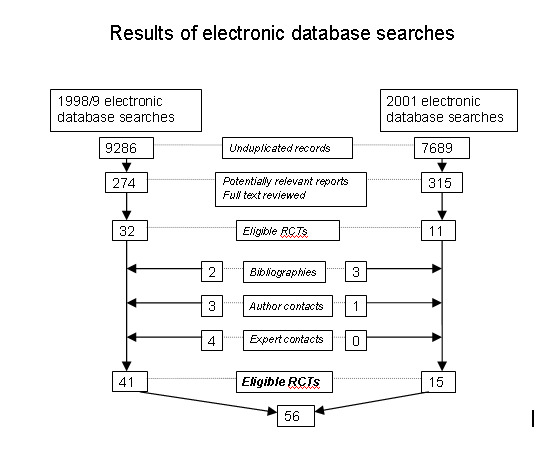
Results of electronic database searches
Of the 56 RCTs, 51 compared an intervention with a no intervention group (i.e. a control or placebo group). One of these trials was ongoing. Five trials compared two different interventions, of which one was ongoing. Trials comparing two different interventions are not included in meta‐analyses.
If the 35 authors who were traceable and contactable, 11 provided additional data, further information on methodology or additional trials (Camp 1977; Cavell 2000; CPPRG 1999; Hudley 1993; Ison 2001; Jones 1991; Lazerson 1980; Meyer 1995; Prinz 1994; Teglasi 2001; Tremblay 1991).
After author contacts, 36 of 56 identified RCTs had data suitable for inclusion in a meta‐analysis, two trials were ongoing, and 18 trials had no or inadequate data available. Of 51 RCTs comparing an intervention with a placebo or control group, none reported violent injury outcomes, 34 reported data on aggressive behaviour either by aggression scale score or by observed aggression, and nine reported data on school or agency responses to aggressive acts.
Four trials randomised to intervention or control/placebo groups by cluster (either school or class) rather than individual, and provided data at the level of the individual (Braswell 1997; CPPRG 1999; Etscheidt 1984; Prinz 1994). These trials were therefore adjusted for clustering.
Risk of bias in included studies
Reporting on the methodology of these trials was generally poor. The methodological quality of the included trials was assessed by the reporting of design and conduct features that are likely to prevent systematic errors or bias.
Of the 56 trials identified, two were ongoing. Of the 54 completed trials, there was almost total absence of reporting of allocation concealment. Twenty‐seven trials gave no information regarding method of randomisation and such information could not be obtained from the author. In the remaining 27 trials, partial information was available on method of randomisation, and in six of these it was apparent that randomisation had been breached prior to intervention. In one trial the absence of allocation concealment was detailed through the reporting of randomisation by open list. No other trial reported the method of allocation concealment. Therefore none of the trials were coded A for allocation concealment, 48 were coded B and six were coded C.
Fifty‐two trials reported collecting information on a measure of aggressive behaviour that was either an aggression scale score or observed aggression. In 18 trials the outcome was reported to be collected blinded, in 14 unblinded, and in the remaining 20 trials information on blinding was not provided.
An intention‐to‐treat analysis has been used in this review for all trials except one (Teglasi 2001) where the number randomised was not quoted and an available case analysis was used. The majority of authors used numbers of participants present at post test and follow up in their analyses, rather than number randomised. Loss to follow‐up varied considerably between studies; changing schools, moving away from the area and absenteeism on the day of the assessment were the commonest reasons for loss to follow‐up.
Due to the generally poor level of reporting of quality indicators of studies, we were unable to conduct meta‐regression to explore heterogeneity in results on the basis of methodology.
Effects of interventions
Results from studies with data suitable for meta‐analysis
Aggressive or violent behaviours on standardised tests or actual counts of aggressive behaviours such as fights or bullying
Of 51 trials comparing an intervention group with a control or placebo group, 45 reported collecting data on teacher completed validated scales of behaviour that assessed aggression, one trial used a peer report measure and one used a self report measure. Four trials used direct observation of pupils' behaviour to detect aggression. Of the teacher completed behaviour scales the commonest used was the Achenbach Child Behavior CheckList ‐ Teacher Report Form, used by authors in 14 trials.
Data were available on 2939 students enrolled in 34 completed trials that measured aggressive or violent behaviours and were suitable for meta‐analysis. Aggressive behaviour was significantly reduced in intervention groups compared to control or placebo groups immediately post intervention (Standardised Mean Difference (SMD) = ‐0.41; 95% CI ‐0.56 to ‐0.26) with significant heterogeneity (Chi2 = 98.84, P<0.00001, I2 = 66.6%). The effect was maintained at follow up in the seven studies reporting outcomes to 12 months (SMD = ‐0.4; 95% CI ‐0.73 to ‐0.06) with significant heterogeneity (Chi2 = 21.11, P<0.002, I2 = 71.6%).
Seven trials used interventions designed to improve relationship or social skills. Post intervention results were beneficial and the differences between groups were greater than would have been expected by chance (SMD = ‐0.61; 95% CI ‐0.87 to ‐0.35), without significant heterogeneity (Chi2 = 9.81, P = 0.13, I2 = 38.8%), though this was based on relatively small numbers of pupils (n= 479). Eighteen trials (containing 943 students) used interventions designed to teach skills of non‐response to provocative situations, either managed or not (e.g. conflict resolution, anger control). Beneficial results were again significant (SMD = ‐0.39; 95% CI ‐0.61 to ‐0.16) but with significant heterogeneity (Chi2 = 44.10, P = 0.0003, I2 = 61.5%). The remaining seven studies of interventions that combined both skills of non‐response and improved relationship skills showed less beneficial, though still significant results (SMD = ‐0.28; 95% CI ‐0.55 to ‐0.01), with moderate heterogeneity (Chi2 = 10.89, P = 0.09, I2 = 44.9%) (n= 594). Two trials of skills of non‐response produced follow‐up data to 4 months (SMD = ‐0.53; 95% CI ‐0.98 to ‐0.08) without heterogeneity (Chi2 = 0.24, P = 0.62, I2 = 0%). Two trials of relationship skills produced follow‐up data to 6 months (SMD = ‐0.43) that could have arisen by chance (95% CI ‐0.94 to 0.08). Similarly, three trials of combined non‐response and relationship skills interventions produced follow‐up results to 12 months showing beneficial results (SMD = ‐0.34) that could have arisen by chance (95% CI ‐0.93 to 0.26).
School or agency responses to aggressive or violent behaviours
Sixteen trials reported collecting information on the responses of schools or other agencies to aggressive or violent behaviours. The commonest measure was disciplinary referrals (e.g. the pupil being sent to the head teacher for poor classroom behaviour). Other measures ranged from a school fine system to school suspensions to court attendances. Nine of these trials, with 1698 participants, reported data on the effects of school or agency actions as a response to violent or aggressive behaviour that could be combined in a meta‐analysis. There was a reduction in school or agency responses that could have arisen by chance (SMD = ‐0.48; 95% CI ‐1.16 to 0.19), and was associated with high heterogeneity (Chi2 = 217.55, P = 0<0.0001, I2 = 96.3%). Only two of these trials reported any longer‐term follow‐up, which indicated minimal effects at two to four months (SMD = 0.03; 95% CI ‐0.42 to 0.47) (Chi2 = 0.25, P = 0.62, I2 = 0%).
Five trials reporting interventions to promote skills of non‐response, produced small beneficial effects on school or agency actions, but not to a degree beyond chance (SMD = ‐0.30, 95% CI ‐0.85 to 0.25). Similar results were produced for two trials reporting interventions designed to promote relationship skills (SMD = ‐0.28; 95% CI ‐1.65 to 1.10). A single trial reported results from 480 pupils randomised to receive an intervention combining both skills of non‐response and relationship skills and produced strongly beneficial results (SMD = ‐1.95; 95% CI ‐2.19 to ‐1.71).
Violent injuries
None of the trials identified reported collecting information on violent injuries.
Subgroup analyses
Primary school versus secondary school Of the 34 completed trials reporting data on aggressive or violent behaviours, 22 were set in schools for children of primary school age (up to and including age 11), and 12 were in school for children of secondary school age (from 12 years up to the school leaving age in that country).
Post intervention results on differences in aggression scale scores or observed aggression were largely similar for both age groups (primary schools; SMD = ‐0.42; 95% CI ‐0.61 to ‐0.24, and secondary schools; SMD = ‐0.41, 95% CI ‐0.56 to ‐0.26), with greater heterogeneity in the primary school‐based trials (Chi2 = 75.14, P < 0.0001, I2 = 72.1%) than in the secondary school‐based trials (Chi2 = 98.84, P = 0.04, I2 = 47.0%). Benefits became less certain at follow‐up in the five primary schools with data (SMD = ‐0.36; 95% CI ‐0.77 to 0.05) but remained significant in the two secondary school trials reporting follow‐up data (SMD = ‐0.40, 95% CI ‐0.73 to ‐0.06)
Nine trials reported school or agency responses to aggression post intervention, two of which were in primary schools, and seven were in secondary schools. Neither primary schools (SMD = 0.15, 95%CI ‐0.37 to 0.67), nor secondary schools (SMD = ‐0.69, 95% CI ‐1.49 to 0.11) showed results greater than could have arisen by chance.
Sex of participants The majority of pupils selected for entry into trials were boys. Twelve of the 34 trials with data were conducted solely on boys, and 22 were conducted on groups of mixed boys and girls. One trial (Hughes 1992) without data for inclusion in the meta‐analysis studied interventions for aggressive girls only.
Post intervention differences in aggression scale scores or observed aggression appeared to be somewhat stronger for mixed sex groups (2234 participants, SMD = ‐0.45; 95% CI ‐0.64 to ‐0.26) than for boys alone (705 participants, SMD = ‐0.35; 95% CI ‐0.61 to ‐0.08), although there is significant overlap in 95% confidence intervals suggesting that apparent differences could be largely due to chance. Both had significant heterogeneity: Chi2 = 67.36, P < 0.00001, I2 = 68.8% (for mixed sex groups), and Chi2 = 27.83, P = 0.003, I2 = 60.5% (for boys only groups). Benefits became imprecise at follow‐up for the two studies of boys alone reporting follow‐up data (SMD = ‐0.38, 95% CI ‐1.02 to 0.26) and for the five studies of mixed sex groups reporting follow‐up data (SMD = ‐0.44; 95%CI ‐0.91 to 0.02).
Nine trials reported school or agency responses to aggression for boys only groups (two trials) and mixed sex groups (seven trials) post intervention. Neither boys only groups (SMD = 0.23; 95% CI ‐0.19 to 0.65), nor mixed sex groups (SMD = ‐0.70; 95% CI ‐1.54 to 0.13) showed results greater than could have arisen by chance. Similarly, the only two trials reporting school or agency follow‐up data (both in mixed sex groups), showed non‐significant results (SMD = 0.03; 95% CI ‐0.42 to 0.47).
Results from studies not in the meta‐analysis
Eighteen trials were identified that did not have data suitable for meta‐analysis; 12 of these compared an intervention group or several intervention groups with a placebo or control group and six compared one intervention with another.
The total number of children involved in the 12 trials comparing an intervention with a placebo or control group was 2687. Nine of the trials were small (with n = 60), while one was much larger (n = 2181) (MACS 2002). Ten of the 12 studies reported a teacher rating of aggressive behaviour at post test. Four of these reported statistically significant differences in favour of the intervention at post test (Feshbach 1979a; Feshbach 1979b; Garrison 1982; Pietrucha 1998), and six reported no overall statistically significant differences (Arbuthnot 1986; Coats 1979; Lazerson 1980; MACS 2002; Petit 1998; Sackles 1981) at post test between intervention and control groups. One study reported observed aggressive behaviour, showing statistically significant improvements as a result of the intervention (Forman 1980), and one study reported a peer rating of aggression at post test which showed a statistically significant benefit between intervention and control groups as a result of the intervention (Bienert 1995). Two studies reported long‐term follow‐up data, one indicated no statistically significant differences between intervention and control groups at nine month follow‐up (Arbuthnot 1986) and the other, which had significant attrition, reported no overall benefits greater than could have occurred by chance in the residual sample that received two extended periods of intervention over four years (n=291) (MACS 2002).
Only one of these 12 studies reported collecting information on the number of disciplinary referrals post intervention (Arbuthnot 1986), and this indicated a statistically significant reduction in number of referrals in the intervention group compared to the control group, that was maintained at nine month follow‐up.
Of the six studies that compared one intervention to another, two were trials assessing the impact of variable intensity of exposure to an intervention programme (Cavell 2000; Hughes 1992), only one of which reported 'statistically significant' differences between groups at post test. This small study (Hughes 1992) (n=20) compared a one day conflict management training for students with a two hour discussion group about conflict management. The difference in teacher ratings of aggressive behaviour for the two groups was statistically significant at post test, in favour of the whole day group. This study was unique in the review in that it was the only study to assess girls only. The remaining four studies compared one intervention with another. Three (Camp 1980; Cavell 2000; Hudley 1998) resulted in no statistically significant differences between groups at post testing, whilst one (Hughes 1993), found that teaching the teachers strategies to deal with conflicts between students was statistically more effective than teaching the students similar strategies directly.
Sensitivity analyses
Five of the trials identified from this review randomised students by clusters (Braswell 1997; Etscheidt 1984; CPPRG 1999; MACS 2002; Prinz 1994). In the four trials with data suitable for inclusion in the meta‐analysis (Braswell 1997; CPPRG 1999; Etscheidt 1984; Prinz 1994) none were considered to have adequately adjusted for clustering. The results of these trials were analysed in the meta‐analysis using a published intraclass correlation coefficient (ICC) of 0.15 (CPPRG 1999b). As a sensitivity analysis meta‐analysis was repeated using values of ICC = 0.1 (SMD = ‐0.42; 95% CI ‐0.57 to ‐0.26) and ICC = 0.2, (SMD = ‐0.41; 95% CI ‐0.56 to ‐0.26), indicating minimal effect on results.
The standard deviation (SD) was imputed for five trials with incomplete reporting, for which the SD could not be obtained from authors (Contreras 1981; Day 1993; Huey 1984; Lochman 1993; Oldfield 1982). Omitting these data from the analysis the effect size was SMD = ‐0.34 (95% CI ‐0.48 to ‐0.19), indicating that a beneficial effect greater than that likely to have occurred by chance persists. The five studies with imputed SDs showed a strong effect (SMD = ‐1.03; 95% CI ‐1.40 to ‐0.66).
As a sensitivity analysis the Generic Inverse Variance meta‐analysis was re‐run as a fixed‐effect model. The result for 34 trials measuring changes in aggressive or violent behaviour by validated rating scale, or observed aggressive behaviour was SMD = ‐0.25 (95% CI ‐0.32 to ‐0.17), similar to the result generated by the random effects model (SMD = ‐0.41; 95% CI ‐0.56 to ‐0.26).
Funnel plot analysis
The results of a funnel plot analysis to assess publication bias are shown in Additional Figure 2. This shows a spread of studies within an inverted funnel, with an absence of smaller studies with negative results.
2.
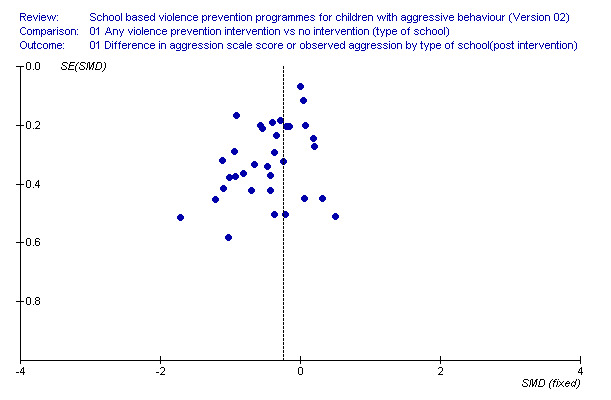
Discussion
Principal findings
This review of school‐based secondary prevention programmes to reduce aggressive and violent behaviour has found that there is evidence that these programmes are capable of producing moderate beneficial effects, as evidenced by improvements in teacher rated or observed behaviour or reductions in the number of school responses to aggressive behaviour such as referrals to the headteacher. The former of these is a change greater than that which might be expected by chance (pooled effect size on measures of aggressive behaviour or observed behaviour was ‐0.41; 95% CI ‐0.56 to ‐0.26). The difficulty arises in interpreting these findings in real terms. The meta‐analysis has used a standardised mean difference between groups to pool the studies, that is, has considered the different methods of assessment as though they were one standardised method. It is therefore not easy to translate this figure back to the original measure to determine the apparent reduction in aggression. Meta‐analyses of interventions to reduce criminality have had to address the same issue. Here, the effect size may be converted into the fraction of people who re‐offend (Farrington 2002). Applying a similar method to our findings, we could consider that if the percentage of children in a control group who demonstrate aggressive behaviour is 50%, an effect size of ‐0.41 would mean that only 30% would demonstrate aggressive behaviour in the intervention group. Similarly, if 50% of children in a control group were referred to the head teacher for aggressive classroom behaviour, then only 26% would be referred in the intervention groups according to the findings of our meta‐analysis.
We did not find any evidence of the effect of school‐based violence prevention interventions on injuries resulting from aggressive behaviour. The association between aggressive or externalising behaviour and injury has been demonstrated in longitudinal cohort studies from different countries including New Zealand (Langley 1983), and Great Britain (Bijur 1986). This strengthens the rationale for the use of aggressive behaviour as a proxy measure for injury.
We have shown that interventions designed to improve relationship or social skills, and interventions designed to teach non‐response to provocative situations, are both capable of producing benefits greater than would have been expected by chance, when delivered independently or in a combined intervention. Interventions designed to improve relationship or social skills appear to be the most beneficial. The type of intervention components delivered, either to individuals or groups, during relationship or social skills training included how to develop good relationships and get on with others by such skills as listening, learning to respond positively to the feelings of yourself and others, understanding how your own behaviour affects the way that other people relate to you, how to work cooperatively with others, or how to assert yourself in a constructive manner. Some of these interventions were combined with interventions in the school environment (e.g. school‐wide activities to promote consideration of others) or in the home environment (e.g. family counselling).
The intervention benefits described may persist to 12 months post intervention, but there is little evidence evaluating whether they can be maintained beyond this period. Two of the trials in this review reported follow‐up beyond 12 months. The study by Tremblay was followed up at three years post intervention (Vitaro 1994) using a teacher reported aggressiveness scale, which indicated significantly lower aggressiveness in the treatment group than the control group (P<0.05) at age 12 years (placebo group not reported), suggesting that beneficial effects may be retained. However, a two year follow‐up of the study by Barkley (Shelton 2000) reported no significant difference between treatment and control groups for teacher ratings of aggressiveness on the Achenbach Child Behaviour Checklist. These results need to be interpreted with caution as treatment groups were collapsed for this later analysis, and intention to treat was not used.
Interventions delivered in the primary and secondary school setting both showed reductions in aggression as assessed by aggression scale scores or observed aggression at post test, and these reductions appeared to be maintained at follow‐up. It is encouraging that despite necessary differences in mode of delivery, these interventions appear beneficial to aggressive children of all ages. This analysis would suggest that it would be inappropriate to focus all preventive attention solely on younger age groups.
Although most programmes focussed either solely or largely on boys, programme effects on aggressive behaviour appeared to be similar among mixed sex groups and boys only groups.
Methodological issues arising in the review
Study quality
The trials included in this review varied considerably in their selection of students, type and duration of intervention, measurement of outcomes, and follow‐up. The reporting of the methodology and quality indicators was generally poor, limiting the assessment of study validity. Despite our attempts to contact all authors, much information remained unavailable, particularly relating to allocation concealment, method of randomisation, use of blinding and loss to follow‐up.
Allocation concealment and blinding
Allocation concealment reduces the chance of producing an error in the estimate of effect through allocation bias (Schulz 1995). In 14 studies randomisation was reported to be achieved by using a table of random numbers, but in only three of these was this stated to be computer generated. Only one trial in this study reported sufficient information to judge allocation concealment (i.e. the table of random numbers was stated to be an 'open list'). The absence of such information threatens our ability to assess the internal validity of the individual trials. Whilst it may not have been possible to conceal their allocation group from pupils, classes or schools (i.e. 'blinding'), 14 studies also failed to blind those who assessed outcomes. This failure risks biased reporting of intervention effects, specifically the overestimation of beneficial effects. In a further 20 studies the use of blinding was unclear, though it can be anticipated that a number of these studies also failed to blind assessors.
Cluster randomisation
In cluster randomised trials groups of students are randomised to intervention or control conditions determined by pre‐existing groupings, in these cases clusters were either schools or classes. Individuals within clusters tend to be more similar than individuals between clusters and this similarity needs to be taken into consideration in analysis. Failure to do so would result in more weight being given to some studies than would be appropriate, and would spuriously narrow the 95% confidence intervals. To avoid unit of analysis errors adjustments should be made by authors to account for the clustering. In the four trials with data suitable for inclusion in the meta‐analysis (Braswell 1997; CPPRG 1999; Etscheidt 1984; Prinz 1994) none were considered to have adequately adjusted for clustering. Although we adjusted these results in the meta‐analysis by incorporating an intraclass correlation coefficient taken from published literature and found similar results for a range of ICCs, our results might nevertheless have differed had the true ICCs from these studies been available, or had cluster‐adjusted results been provided by the authors. In the fifth cluster randomised trial (MACS 2002), the information available was insufficient for us to identify and adjust appropriate values for inclusion in the meta‐analysis without making assumptions about which we could not be confident. This study was therefore reported narratively.
Effect of imputing standard deviations
We found substantial differences between studies that reported standard deviations, and those for which the SD has to be imputed. The difference in SMD between the studies where the SD was imputed and those where it was published may have been due to quality differences. Methodologically weaker studies, which may be less likely to report complete data, tend to show larger effect sizes (Schulz 1995). Excluding trials where the SD was imputed tended to reduce the overall effect size but did not change its direction.
Heterogeneity of results
The tests for heterogeneity indicated wide variations in effects of studies. An important cause of heterogeneity is baseline risk varying between studies. Baseline risk represents a combination of known and unknown risk factors. As the studies in this review included aggressive students identified as aggressive by author defined criteria they varied in their level of high‐risk status. Because of inadequate reporting on these processes for many trials, and difficulty in establishing population rates for service actions on which the selections were based (e.g. referrals to the head teacher for aggressive behaviour), we could not explore whether programme effectiveness varied according to how aggressive the children were at selection. Investigating this relationship is complicated by regression to the mean, since the control group risk forms an integral part of the effect estimate.
Publication bias
We used a funnel plot to indicate publication bias in our meta‐analysis. In funnel plots, results from small studies tend to scatter widely at the bottom, with the spread narrowing among larger studies, so that the plot should represent a symmetrical inverted funnel. Asymmetry or gaps in the funnel plot may indicate publication bias, i.e. that some studies or study data exist that may not have been published or located. But asymmetry can also be explained by the poor methodological quality of smaller studies (which tend to show larger effect sizes) or true heterogeneity in the results, such as differences in baseline variables between studies, study quality and duration and intensity of the interventions. We found that age, sex and type of intervention all contributed to the heterogeneity identified but did not fully explain it. Studies included in this review varied substantially with respect to their reporting of study quality (e.g. allocation concealment, method of randomisation and use of blinding), and reporting of these variables was so poor that exploration of heterogeneity by meta‐regression was not possible. We identified 18 trials that were not suitable for inclusion in our meta‐analysis, 12 of which would have been included had data been available. Absence of these data may have influenced our findings.
Unpublished studies tend to be smaller in size and therefore less powerful, but may be less prone to issues such as publication bias. Conversely, published studies are often larger, and more powerful, but by virtue of being published are prone to publication bias, therefore a sensitivity analysis was done for both published and unpublished studies. Of the 34 studies with data suitable for inclusion in the meta‐analysis, four (Braswell 1997; CPPRG 1999; Harris 1992; Walker 1998) were identified initially by author or expert contact, although all have subsequently had reports with data published. We therefore did not identify any data that was from unpublished work.
Choice of method of analysis
An intention‐to‐treat analysis was used in the meta‐analysis in all but one study (Teglasi 2001), where the number randomised was not reported, and an available case analysis was used.
Most of the trials included in the meta‐analysis comparing any violence prevention intervention to no intervention were small (22 out of 34 trials included less than 60 participants). Therefore, although randomised, differences in the baseline characteristics between pretest scores could have arisen by chance. Differences between pretest and posttest scores were not available for the majority of studies (20 out of 34 trials reported results only on those children available at post test). Therefore the post test scores were used, adjusted for pretest differences where this information was reported.
Our subgroup analyses were specified a priori, and therefore these observational findings are eligible to contribute to the conclusions of the review. Ideally, subgroups should contain >10 studies (Alderson 2004), which was the case for our analyses of primary school versus secondary school interventions and for analyses comparing boys only groups with mixed sex groups. However, our analysis relating to type of intervention produced three groups; skills of non‐response, relationship / social skills and interventions that combined both non‐response skills and relationship / social skills. The latter two of these groups resulted in analyses run on seven studies each. We believe that the differences between subgroups identified in this review are of practical importance as they suggest the most effective type and setting of interventions for aggressive children. We sought evidence to support our meta‐analysis findings on type of intervention, in the six studies that compared one intervention to another (and were therefore unsuitable for inclusion in the meta‐analysis). None of these six studies compared an intervention of relationship / social skills with one of teaching skills of non‐response. However, one study (Cavell 2000) compared an enhanced mentoring programme (which combined teaching problem solving skills with family and mentoring work) with a standard mentoring programme. This study assessed teacher rated aggressive behaviour and indicated no significant difference between the groups ratings at either post test or follow‐up, though both groups reduced their rating of aggression with time.
Generic inverse variance methods of meta‐analysis were used in this review. The GIV meta‐analysis was run as a random‐effects model to account for the heterogeneity between studies, indicating the average treatment effect. However, the majority of the studies included in the meta‐analysis were relatively small (22 of the 34 trials with data involved 60 participants or less), save for two trials (Braswell 1997; CPPRG 1999) where the numbers of participants were 309 and 891, respectively. It could be argued that a random effects model that weights studies more or less equally is inappropriate in these circumstances, and that these two trials could justifiably be weighted more heavily. Therefore as a sensitivity analysis the GIV meta‐analysis was re‐run as a fixed‐effect model. The results were similar to the results generated by the random effects model, suggesting that a random‐effects model was an appropriate method of analysis considering the degree of heterogeneity reported.
Interpretive issues arising in this review
The usefulness of a systematic review depends upon the ability of its inclusion criteria to apply to populations of local interest. In selecting the participants of this review we sought to include children of all ages within the mandatory education system of their country, in order to be relevant to as wide an audience as possible. It should be acknowledged that the majority of these trials were based in the United States of America. Of 51 identified RCTs, one was from Australia (Jones 1991), two were from Argentina (Ison 1997; Ison 2001), five were from Canada (Bienert 1995; Day 1993; Lee 1979; Pepler 1995; Tremblay 1991) and the remaining 43 were from the US.
As stated, trials varied considerably in their selection processes for identifying children demonstrating aggressive behaviour, and the duration and intensity of the interventions applied also varied widely, from a single two‐hour discussion group on conflict resolution (Hughes 1992) to over 53 hours of intervention spread over two years (MACS 2002). Therefore the reporting of studies with such variety of participants and interventions was very important. Unfortunately reporting of study design and quality was generally poor, and attempts to contact all authors did not wholly rectify this problem. Inclusion criteria were strictly adhered to and judgements and assumptions minimised, preferring to exclude studies if doubts persisted about eligibility criteria. Despite this, the variability of studies is reflected in the statistical heterogeneity identified through meta‐analysis.
In producing this review we have sought to be comprehensive in our reporting and transparent in our methodology, in an attempt to provide an unbiased review of the evidence available. Yet we must acknowledge that in this review, as in any review, methodological decisions made along the way by us as reviewers have been based on our judgements and opinions, and are therefore not immune to comment or criticism. In addition, the findings of this review need to be considered in the context of secondary prevention interventions in non‐school settings, effective primary prevention interventions to reduce violence, and the changing social contexts and experiences of children and adolescents.
Authors' conclusions
Implications for practice.
School‐based interventions targeted to children exhibiting aggressive or violent behaviours are beneficial in reducing both reported or observed aggressive behaviour and school responses to aggression, such as referrals to the headteacher. Interventions designed to improve relationship skills or social skills may be more effective than interventions designed to teach skills of non‐response to provocative situations. Primary or secondary school settings are capable of producing beneficial results with these interventions, and these results do not therefore support the premise that interventions to address aggressive behaviour have to be commenced at as early an age as possible. Interventions can be beneficial when delivered to either mixed sex or boys alone groups.
Implications for research.
This review has provided evidence that school‐based secondary prevention programmes are effective in reducing aggressive behaviour. To utilise this knowledge, questions that now need to be addressed include whether the beneficial effects can be maintained outside an experimental intervention setting, whether the beneficial effects can be replicated in contexts other than standard school settings (such as special school provision or youth detention facilities), and whether they can be replicated in countries other than those where the research was conducted. This review has highlighted areas where existing research either has not been identified or where available evidence is inconclusive. The review was not able to identify any evidence of the effect of school‐based programmes to reduce the occurrence of aggression‐related injury. Also, it has not been possible to establish whether the effects of these interventions can be sustained in the long term (greater than 12 months), or whether there are specific components of the interventions that result in more beneficial outcomes than others. The cost effectiveness of such interventions needs to be established before widespread dissemination of programmes should be considered. These issues are all areas for further primary research.
The poor reporting of studies we encountered limited our ability to adequately assess study quality. We would encourage the use of guidelines and standards of reporting (such as CONSORT) in all new randomised controlled trials of such interventions to facilitate the assessment of study validity in the future.
What's new
| Date | Event | Description |
|---|---|---|
| 27 July 2009 | Amended | Some references have been amended. |
History
Protocol first published: Issue 1, 2004 Review first published: Issue 3, 2006
| Date | Event | Description |
|---|---|---|
| 11 September 2008 | Amended | Converted to new review format. |
Notes
Earlier analyses of these data have been reported in:
Mytton JA, DiGuiseppi C, Gough DA, Taylor RS and Logan S School based violence prevention programs: Systematic review of secondary prevention trials. Archives of Pediatrics and Adolescent Medicine 2002:156;752‐62.
DiGuiseppi C, Mytton JA, Gough DA, Taylor RS and Logan S School based violence prevention programs: Systematic review of secondary prevention trials. Report prepared for the Agency for Healthcare Research and Quality, U.S. Department of Health and Human Services, Rockville, Maryland, June 30, 2003.
Acknowledgements
Ian Roberts (London School of Hygiene and Tropical Medicine), Katharine Ker (Cochrane Injuries Group), Jonathan Sterne (Department of Social Medicine, University of Bristol).
Appendices
Appendix 1. Search strategy
The searches were based on the following MEDLINE strategy:
1."VIOLENCE"/ all subheadings 2."DANGEROUS‐BEHAVIOR" 3."AGGRESSION"/ all subheadings 4."HOSTILITY‐"/ all subheadings 5."FIREARMS"/ all subheadings 6."SUICIDE"/ all subheadings 7."SUICIDE,‐ATTEMPTED"/ all subheadings 8."RAPE"/ all subheadings 9."CRIME‐VICTIMS"/ all subheadings 10."JUVENILE‐DELINQUENCY" / all subheadings 11.violen* or aggress* or angry or hostil* or bully* or bullie* or fight* or fought or firearm* 12.fire near arm* 13.suicid* or homicid* or conflict* or resol* or mediation 14.conflict* near (resol* or mediation) 15.(antisocial or agonis*) near behavi* 16.weapon* or knife or knives or gun or guns or assault* or anger or delinquen* 17.#1 or #2 or #3 or #4 or #5 or #6 or #7 or #8 or #9 or #10 or #11 or #12 or #13 or #14 or #15 or #16 18."SCHOOL‐HEALTH‐SERVICES"/ all subheadings 19."SCHOOLS"/ all subheadings 20."EDUCATION"/ all subheadings 21.explode "CURRICULUM"/ all subheadings 22.explode "TEACHING"/ all subheadings 23."HEALTH‐EDUCATION"/ all subheadings 24."MENTORS"/ all subheadings 25."STUDENT‐DROPOUTS"/ all subheadings 26."STUDENTS"/ all subheadings 27.school* or high‐school or educat*or student* or "peer‐group" or peer or peers or curricul* or teach* or mentor* 28.#18 or #19 or #20 or #21 or #22 or #23 or #24 or #25 or #26 or #27 29.#17 AND #28 30."CHILD‐"/ all subheadings 31."ADOLESCENCE"/ all subheadings 32."CHILD,‐PRESCHOOL"/ all subheadings 33.#30 or #31 or #32 34."ADULT"/ all subheadings 35."MIDDLE‐AGE"/ all subheadings 36."AGED"/ all subheadings 37."AGED,‐80‐AND‐OVER"/ all subheadings 38."INFANT‐" 39."INFANT,‐NEWBORN"/ all subheadings 40.#34 or #35 or #36 or #37 or #38 or #39 41.#33 AND #40 42.#40 NOT #41 43.#33 NOT #42 44.#29 AND #43
Data and analyses
Comparison 1. Any violence prevention intervention versus no intervention by type of school.
| Outcome or subgroup title | No. of studies | No. of participants | Statistical method | Effect size |
|---|---|---|---|---|
| 1 Difference in aggression scale score or observed aggression by type of school (post test) | 34 | 2939 | SMD (Random, 95% CI) | ‐0.41 [‐0.56, ‐0.26] |
| 1.1 Primary school | 22 | 2375 | SMD (Random, 95% CI) | ‐0.42 [‐0.61, ‐0.24] |
| 1.2 Secondary school | 12 | 564 | SMD (Random, 95% CI) | ‐0.39 [‐0.65, ‐0.14] |
| 2 Difference in aggression scale score or observed violence by type of school (up to 12/12) | 7 | 673 | SMD (Random, 95% CI) | ‐0.40 [‐0.73, ‐0.06] |
| 2.1 Primary schools | 5 | 590 | SMD (Random, 95% CI) | ‐0.36 [‐0.77, 0.05] |
| 2.2 Secondary schools | 2 | 83 | SMD (Random, 95% CI) | ‐0.53 [‐0.98, ‐0.08] |
| 3 Difference in school response to aggressive acts + other acts by school (post test) | 9 | 1698 | SMD (Random, 95% CI) | ‐0.48 [‐1.16, 0.19] |
| 3.1 Primary schools | 2 | 939 | SMD (Random, 95% CI) | 0.15 [‐0.37, 0.67] |
| 3.2 Secondary schools | 7 | 759 | SMD (Random, 95% CI) | ‐0.69 [‐1.49, 0.11] |
| 4 Difference in school response to aggressive acts + other acts by school (up to 12 months) | 2 | 83 | SMD (Random, 95% CI) | 0.03 [‐0.42, 0.47] |
| 4.1 Primary schools | 0 | 0 | SMD (Random, 95% CI) | 0.0 [0.0, 0.0] |
| 4.2 Secondary schools | 2 | 83 | SMD (Random, 95% CI) | 0.03 [‐0.42, 0.47] |
1.1. Analysis.
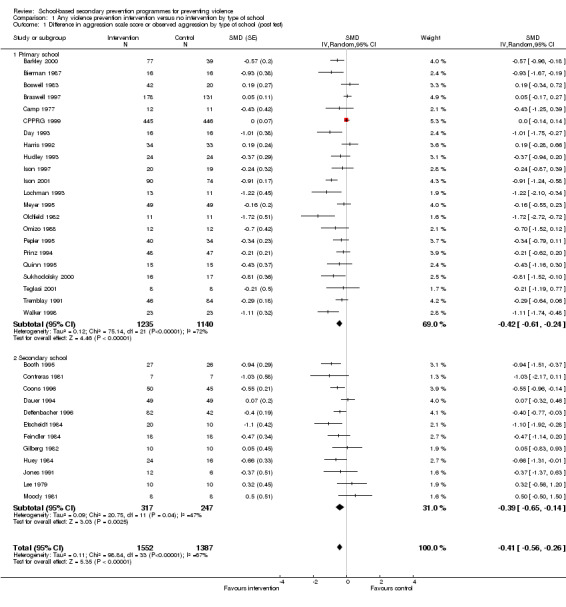
Comparison 1 Any violence prevention intervention versus no intervention by type of school, Outcome 1 Difference in aggression scale score or observed aggression by type of school (post test).
1.2. Analysis.
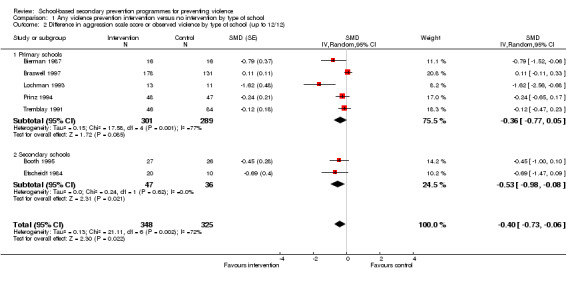
Comparison 1 Any violence prevention intervention versus no intervention by type of school, Outcome 2 Difference in aggression scale score or observed violence by type of school (up to 12/12).
1.3. Analysis.
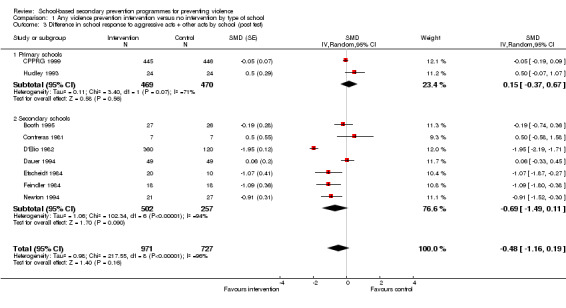
Comparison 1 Any violence prevention intervention versus no intervention by type of school, Outcome 3 Difference in school response to aggressive acts + other acts by school (post test).
1.4. Analysis.
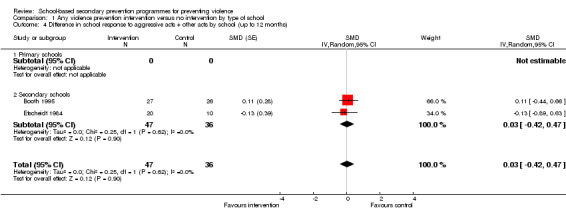
Comparison 1 Any violence prevention intervention versus no intervention by type of school, Outcome 4 Difference in school response to aggressive acts + other acts by school (up to 12 months).
Comparison 2. Anger/conflict response interventions versus no intervention by type of school.
| Outcome or subgroup title | No. of studies | No. of participants | Statistical method | Effect size |
|---|---|---|---|---|
| 1 Difference in aggression scale score or observed aggression by type of school (post test) | 18 | 943 | SMD (Random, 95% CI) | ‐0.39 [‐0.61, ‐0.16] |
| 1.1 Primary school | 10 | 546 | SMD (Random, 95% CI) | ‐0.46 [‐0.78, ‐0.15] |
| 1.2 Secondary school | 8 | 397 | SMD (Random, 95% CI) | ‐0.29 [‐0.64, 0.06] |
| 2 Difference in aggression scale score or observed violence by type of school (up to 12/12) | 2 | 83 | SMD (Random, 95% CI) | ‐0.53 [‐0.98, ‐0.08] |
| 2.1 Primary school | 0 | 0 | SMD (Random, 95% CI) | 0.0 [0.0, 0.0] |
| 2.2 Secondary school | 2 | 83 | SMD (Random, 95% CI) | ‐0.53 [‐0.98, ‐0.08] |
| 3 Difference in school response to aggressive acts + other acts by school (post test) | 5 | 265 | SMD (Random, 95% CI) | ‐0.30 [‐0.85, 0.25] |
| 3.1 Primary school | 1 | 48 | SMD (Random, 95% CI) | 0.5 [‐0.07, 1.07] |
| 3.2 Secondary school | 4 | 217 | SMD (Random, 95% CI) | ‐0.50 [‐1.09, 0.08] |
| 4 Difference in school response to aggressive acts + other acts by school (up to 12 months) | 2 | 83 | SMD (Random, 95% CI) | 0.03 [‐0.42, 0.47] |
| 4.1 Primary school | 0 | 0 | SMD (Random, 95% CI) | 0.0 [0.0, 0.0] |
| 4.2 Secondary school | 2 | 83 | SMD (Random, 95% CI) | 0.03 [‐0.42, 0.47] |
2.1. Analysis.
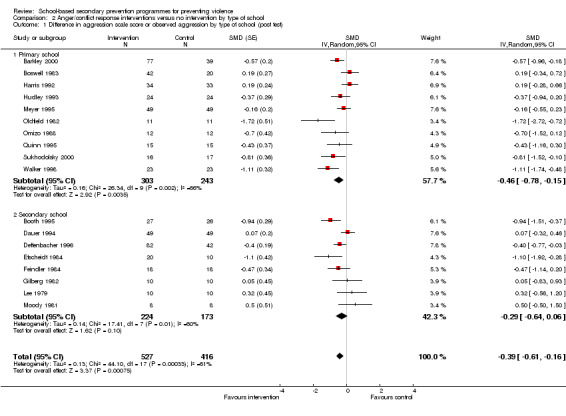
Comparison 2 Anger/conflict response interventions versus no intervention by type of school, Outcome 1 Difference in aggression scale score or observed aggression by type of school (post test).
2.2. Analysis.
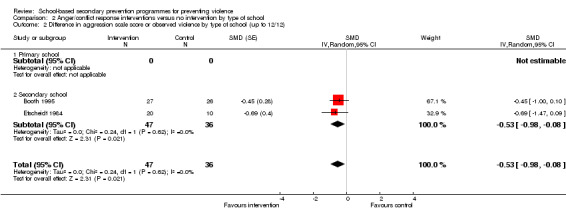
Comparison 2 Anger/conflict response interventions versus no intervention by type of school, Outcome 2 Difference in aggression scale score or observed violence by type of school (up to 12/12).
2.3. Analysis.
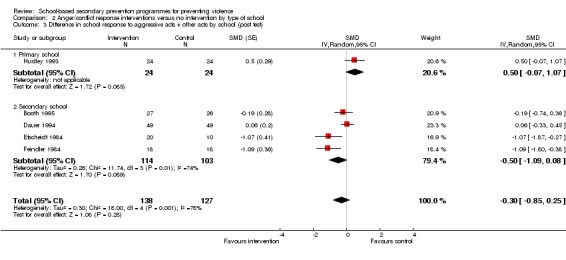
Comparison 2 Anger/conflict response interventions versus no intervention by type of school, Outcome 3 Difference in school response to aggressive acts + other acts by school (post test).
2.4. Analysis.
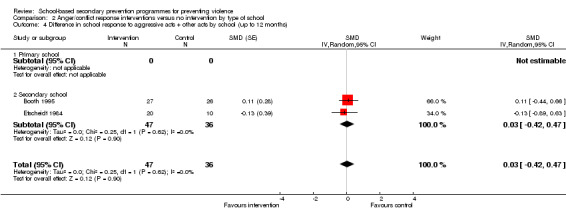
Comparison 2 Anger/conflict response interventions versus no intervention by type of school, Outcome 4 Difference in school response to aggressive acts + other acts by school (up to 12 months).
Comparison 3. Social skills & context interventions versus no intervention by type of school.
| Outcome or subgroup title | No. of studies | No. of participants | Statistical method | Effect size |
|---|---|---|---|---|
| 1 Difference in aggression scale score or observed aggression by type of school (post test) | 7 | 479 | SMD (Random, 95% CI) | ‐0.61 [‐0.87, ‐0.35] |
| 1.1 Primary school | 4 | 330 | SMD (Random, 95% CI) | ‐0.58 [‐1.02, ‐0.15] |
| 1.2 Secondary school | 3 | 149 | SMD (Random, 95% CI) | ‐0.62 [‐0.95, ‐0.29] |
| 2 Difference in aggression scale score or observed violence by type of school (up to 12/12) | 2 | 127 | SMD (Random, 95% CI) | ‐0.43 [‐0.94, 0.08] |
| 2.1 Primary school | 2 | 127 | SMD (Random, 95% CI) | ‐0.43 [‐0.94, 0.08] |
| 2.2 Secondary school | 0 | 0 | SMD (Random, 95% CI) | 0.0 [0.0, 0.0] |
| 3 Difference in school response to aggressive acts + other acts by school (post test) | 2 | 62 | SMD (Random, 95% CI) | ‐0.28 [‐1.65, 1.10] |
| 3.1 Primary school | 0 | 0 | SMD (Random, 95% CI) | 0.0 [0.0, 0.0] |
| 3.2 Secondary school | 2 | 62 | SMD (Random, 95% CI) | ‐0.28 [‐1.65, 1.10] |
| 4 Difference in school response to aggressive acts + other acts by school (up to 12 months) | 0 | 0 | SMD (Random, 95% CI) | 0.0 [0.0, 0.0] |
| 4.1 Primary school | 0 | 0 | SMD (Random, 95% CI) | 0.0 [0.0, 0.0] |
| 4.2 Secondary school | 0 | 0 | SMD (Random, 95% CI) | 0.0 [0.0, 0.0] |
3.1. Analysis.
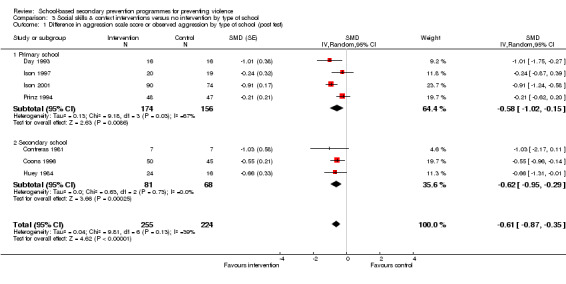
Comparison 3 Social skills & context interventions versus no intervention by type of school, Outcome 1 Difference in aggression scale score or observed aggression by type of school (post test).
3.2. Analysis.
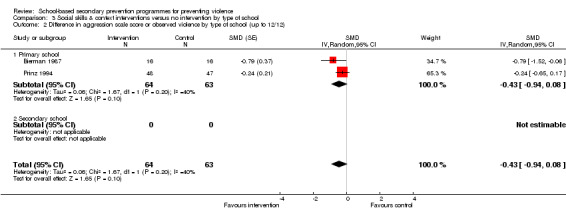
Comparison 3 Social skills & context interventions versus no intervention by type of school, Outcome 2 Difference in aggression scale score or observed violence by type of school (up to 12/12).
3.3. Analysis.
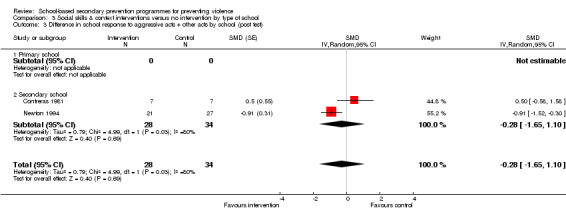
Comparison 3 Social skills & context interventions versus no intervention by type of school, Outcome 3 Difference in school response to aggressive acts + other acts by school (post test).
Comparison 4. Combined anger response & social skills interventions versus no intervention by type of school.
| Outcome or subgroup title | No. of studies | No. of participants | Statistical method | Effect size |
|---|---|---|---|---|
| 1 Difference in aggression scale score or observed aggression by type of school (post test) | 7 | 594 | SMD (Random, 95% CI) | ‐0.28 [‐0.55, ‐0.01] |
| 1.1 Primary school | 6 | 576 | SMD (Random, 95% CI) | ‐0.28 [‐0.58, 0.01] |
| 1.2 Secondary school | 1 | 18 | SMD (Random, 95% CI) | ‐0.37 [‐1.37, 0.63] |
| 2 Difference in aggression scale score or observed violence by type of school (up to 12/12) | 3 | 463 | SMD (Random, 95% CI) | ‐0.34 [‐0.93, 0.26] |
| 2.1 Primary school | 3 | 463 | SMD (Random, 95% CI) | ‐0.34 [‐0.93, 0.26] |
| 2.2 Secondary school | 0 | 0 | SMD (Random, 95% CI) | 0.0 [0.0, 0.0] |
| 3 Difference in school response to aggressive acts + other acts by school (post test) | 1 | 480 | SMD (Random, 95% CI) | ‐1.95 [‐2.19, ‐1.71] |
| 3.1 Primary school | 0 | 0 | SMD (Random, 95% CI) | 0.0 [0.0, 0.0] |
| 3.2 Secondary school | 1 | 480 | SMD (Random, 95% CI) | ‐1.95 [‐2.19, ‐1.71] |
| 4 Difference in school response to aggressive acts + other acts by school (up to 12 months) | 0 | 0 | SMD (Random, 95% CI) | 0.0 [0.0, 0.0] |
| 4.1 Primary school | 0 | 0 | SMD (Random, 95% CI) | 0.0 [0.0, 0.0] |
| 4.2 Secondary school | 0 | 0 | SMD (Random, 95% CI) | 0.0 [0.0, 0.0] |
4.1. Analysis.
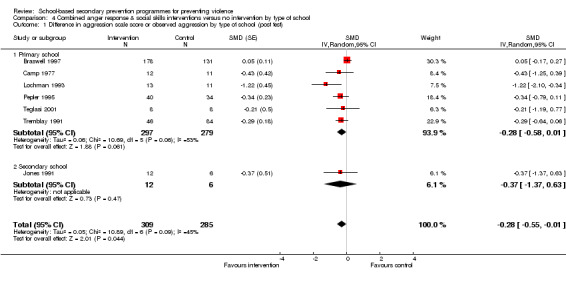
Comparison 4 Combined anger response & social skills interventions versus no intervention by type of school, Outcome 1 Difference in aggression scale score or observed aggression by type of school (post test).
4.2. Analysis.
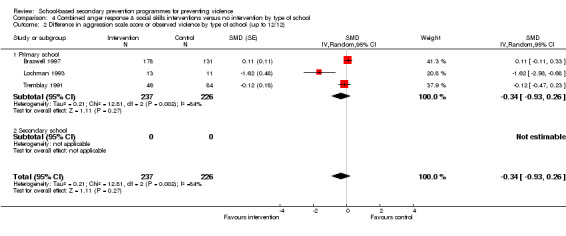
Comparison 4 Combined anger response & social skills interventions versus no intervention by type of school, Outcome 2 Difference in aggression scale score or observed violence by type of school (up to 12/12).
4.3. Analysis.
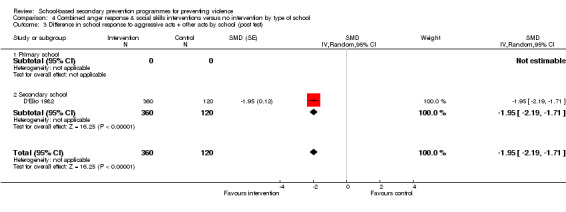
Comparison 4 Combined anger response & social skills interventions versus no intervention by type of school, Outcome 3 Difference in school response to aggressive acts + other acts by school (post test).
Comparison 5. Any violence prevention intervention versus no intervention by sex.
| Outcome or subgroup title | No. of studies | No. of participants | Statistical method | Effect size |
|---|---|---|---|---|
| 1 Difference in aggression scale score or observed aggression by sex (post test) | 34 | 2939 | SMD (Random, 95% CI) | ‐0.41 [‐0.56, ‐0.26] |
| 1.1 All boys | 12 | 705 | SMD (Random, 95% CI) | ‐0.35 [‐0.61, ‐0.08] |
| 1.2 Not all boys | 22 | 2234 | SMD (Random, 95% CI) | ‐0.45 [‐0.64, ‐0.26] |
| 2 Difference in aggresion scale score or observed aggression by sex (up to 12 months) | 7 | 673 | SMD (Random, 95% CI) | ‐0.40 [‐0.73, ‐0.06] |
| 2.1 All boys | 2 | 162 | SMD (Random, 95% CI) | ‐0.38 [‐1.02, 0.26] |
| 2.2 Not all boys | 5 | 511 | SMD (Random, 95% CI) | ‐0.44 [‐0.91, 0.02] |
| 3 Difference in school response to aggressive acts + other acts by sex (post test) | 9 | 1698 | SMD (Random, 95% CI) | ‐0.48 [‐1.16, 0.19] |
| 3.1 All boys | 2 | 146 | SMD (Random, 95% CI) | 0.23 [‐0.19, 0.65] |
| 3.2 Not all boys | 7 | 1552 | SMD (Random, 95% CI) | ‐0.70 [‐1.54, 0.13] |
| 4 Difference in school response to aggressive acts + other acts by sex (up to 12 months) | 2 | 83 | SMD (Random, 95% CI) | 0.03 [‐0.42, 0.47] |
| 4.1 All boys | 0 | 0 | SMD (Random, 95% CI) | 0.0 [0.0, 0.0] |
| 4.2 Not all boys | 2 | 83 | SMD (Random, 95% CI) | 0.03 [‐0.42, 0.47] |
5.1. Analysis.

Comparison 5 Any violence prevention intervention versus no intervention by sex, Outcome 1 Difference in aggression scale score or observed aggression by sex (post test).
5.2. Analysis.
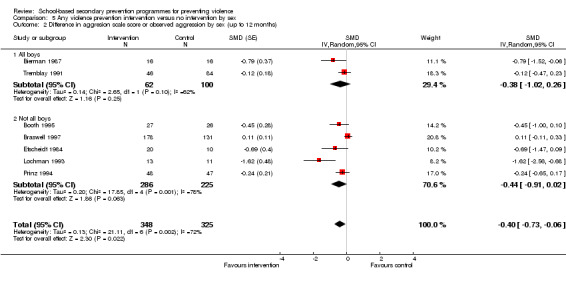
Comparison 5 Any violence prevention intervention versus no intervention by sex, Outcome 2 Difference in aggresion scale score or observed aggression by sex (up to 12 months).
5.3. Analysis.
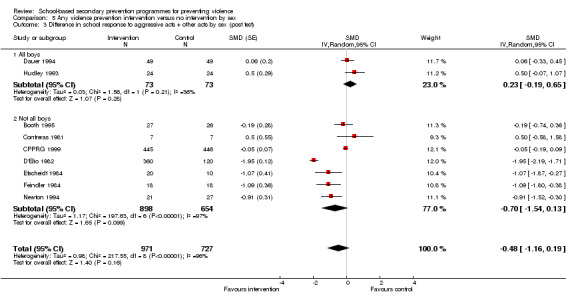
Comparison 5 Any violence prevention intervention versus no intervention by sex, Outcome 3 Difference in school response to aggressive acts + other acts by sex (post test).
5.4. Analysis.

Comparison 5 Any violence prevention intervention versus no intervention by sex, Outcome 4 Difference in school response to aggressive acts + other acts by sex (up to 12 months).
Comparison 6. Anger/conflict response interventions versus no intervention by sex.
| Outcome or subgroup title | No. of studies | No. of participants | Statistical method | Effect size |
|---|---|---|---|---|
| 1 Difference in aggression scale score or observed aggression by sex (post test) | 18 | 943 | SMD (Random, 95% CI) | ‐0.39 [‐0.61, ‐0.16] |
| 1.1 All boys | 6 | 277 | SMD (Random, 95% CI) | ‐0.08 [‐0.40, 0.24] |
| 1.2 Not all boys | 12 | 666 | SMD (Random, 95% CI) | ‐0.53 [‐0.81, ‐0.26] |
| 2 Difference in aggression scale score or observed violence by sex (up to 12 months) | 2 | 83 | SMD (Random, 95% CI) | ‐0.53 [‐0.98, ‐0.08] |
| 2.1 All boys | 0 | 0 | SMD (Random, 95% CI) | 0.0 [0.0, 0.0] |
| 2.2 Not all boys | 2 | 83 | SMD (Random, 95% CI) | ‐0.53 [‐0.98, ‐0.08] |
| 3 Difference in school response to aggressive acts + other acts by sex (post test) | 5 | 152 | SMD (Random, 95% CI) | 0.23 [‐0.19, 0.65] |
| 3.1 All boys | 2 | 146 | SMD (Random, 95% CI) | 0.23 [‐0.19, 0.65] |
| 3.2 Not all boys | 3 | 6 | SMD (Random, 95% CI) | 0.0 [0.0, 0.0] |
| 4 Difference in school response to aggressive acts + other acts by sex (up to 12 months) | 2 | 83 | SMD (Random, 95% CI) | 0.03 [‐0.42, 0.47] |
| 4.1 All boys | 0 | 0 | SMD (Random, 95% CI) | 0.0 [0.0, 0.0] |
| 4.2 Not all boys | 2 | 83 | SMD (Random, 95% CI) | 0.03 [‐0.42, 0.47] |
6.1. Analysis.
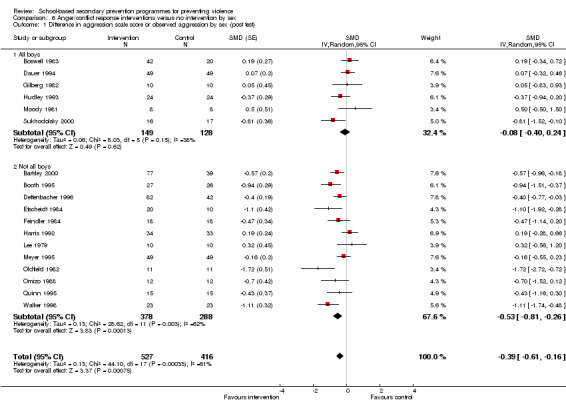
Comparison 6 Anger/conflict response interventions versus no intervention by sex, Outcome 1 Difference in aggression scale score or observed aggression by sex (post test).
6.2. Analysis.

Comparison 6 Anger/conflict response interventions versus no intervention by sex, Outcome 2 Difference in aggression scale score or observed violence by sex (up to 12 months).
6.3. Analysis.
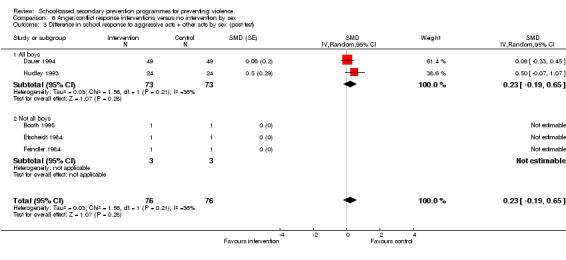
Comparison 6 Anger/conflict response interventions versus no intervention by sex, Outcome 3 Difference in school response to aggressive acts + other acts by sex (post test).
6.4. Analysis.
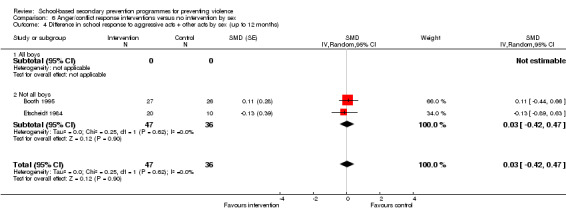
Comparison 6 Anger/conflict response interventions versus no intervention by sex, Outcome 4 Difference in school response to aggressive acts + other acts by sex (up to 12 months).
Comparison 7. Social skills & context interventions versus no intervention by sex.
| Outcome or subgroup title | No. of studies | No. of participants | Statistical method | Effect size |
|---|---|---|---|---|
| 1 Difference in aggression scale score or observed aggression by sex (post test) | 8 | 511 | SMD (Random, 95% CI) | ‐0.63 [‐0.87, ‐0.40] |
| 1.1 All boys | 4 | 275 | SMD (Random, 95% CI) | ‐0.74 [‐1.04, ‐0.44] |
| 1.2 Not all boys | 4 | 236 | SMD (Random, 95% CI) | ‐0.55 [‐0.90, ‐0.19] |
| 2 Difference in aggression scale score or observed aggression by sex (up to 12 months) | 2 | 127 | SMD (Random, 95% CI) | ‐0.43 [‐0.94, 0.08] |
| 2.1 All boys | 1 | 32 | SMD (Random, 95% CI) | ‐0.79 [‐1.52, ‐0.06] |
| 2.2 Not all boys | 1 | 95 | SMD (Random, 95% CI) | ‐0.24 [‐0.65, 0.17] |
| 3 Difference in school response to aggressive acts + other acts by sex (post test) | 2 | 62 | SMD (Random, 95% CI) | ‐0.28 [‐1.65, 1.10] |
| 3.1 All boys | 0 | 0 | SMD (Random, 95% CI) | 0.0 [0.0, 0.0] |
| 3.2 Not all boys | 2 | 62 | SMD (Random, 95% CI) | ‐0.28 [‐1.65, 1.10] |
| 4 Difference in school response to aggressive acts + other acts by sex (up to 12 months) | 0 | 0 | SMD (Random, 95% CI) | 0.0 [0.0, 0.0] |
| 4.1 All boys | 0 | 0 | SMD (Random, 95% CI) | 0.0 [0.0, 0.0] |
| 4.2 Not all boys | 0 | 0 | SMD (Random, 95% CI) | 0.0 [0.0, 0.0] |
7.1. Analysis.
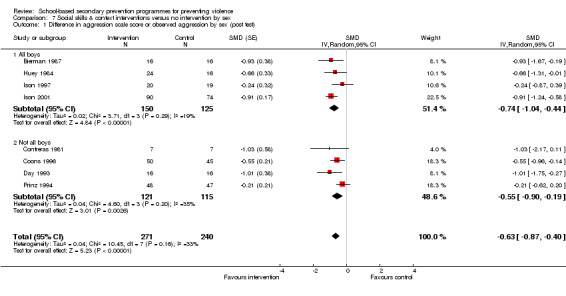
Comparison 7 Social skills & context interventions versus no intervention by sex, Outcome 1 Difference in aggression scale score or observed aggression by sex (post test).
7.2. Analysis.
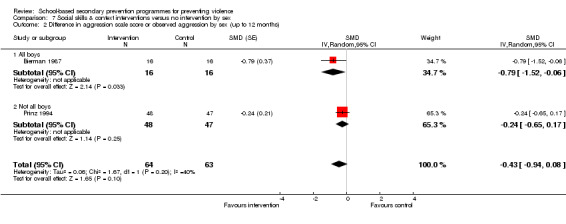
Comparison 7 Social skills & context interventions versus no intervention by sex, Outcome 2 Difference in aggression scale score or observed aggression by sex (up to 12 months).
7.3. Analysis.
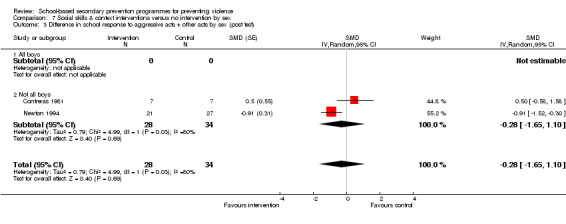
Comparison 7 Social skills & context interventions versus no intervention by sex, Outcome 3 Difference in school response to aggressive acts + other acts by sex (post test).
Comparison 8. Combined anger response & social skills interventions versus no intervention by sex.
| Outcome or subgroup title | No. of studies | No. of participants | Statistical method | Effect size |
|---|---|---|---|---|
| 1 Difference in aggression scale score or observed aggression by sex (post test) | 6 | 576 | SMD (Random, 95% CI) | ‐0.28 [‐0.58, 0.01] |
| 1.1 All boys | 2 | 153 | SMD (Random, 95% CI) | ‐0.31 [‐0.64, 0.01] |
| 1.2 Not all boys | 4 | 423 | SMD (Random, 95% CI) | ‐0.32 [‐0.79, 0.15] |
| 2 Difference in aggression scale score or observed aggression by sex (up to 12 months) | 3 | 463 | SMD (Random, 95% CI) | ‐0.34 [‐0.93, 0.26] |
| 2.1 All boys | 1 | 130 | SMD (Random, 95% CI) | ‐0.12 [‐0.47, 0.23] |
| 2.2 Not all boys | 2 | 333 | SMD (Random, 95% CI) | ‐0.69 [‐2.38, 1.00] |
| 3 Difference in school response to aggressive acts + other acts by sex (post test) | 1 | 480 | SMD (Random, 95% CI) | ‐1.95 [‐2.19, ‐1.71] |
| 3.1 All boys | 0 | 0 | SMD (Random, 95% CI) | 0.0 [0.0, 0.0] |
| 3.2 Not all boys | 1 | 480 | SMD (Random, 95% CI) | ‐1.95 [‐2.19, ‐1.71] |
| 4 Difference in school response to aggressive acts + other acts by sex (up to 12 months) | 0 | 0 | SMD (Random, 95% CI) | 0.0 [0.0, 0.0] |
| 4.1 All boys | 0 | 0 | SMD (Random, 95% CI) | 0.0 [0.0, 0.0] |
| 4.2 Not all boys | 0 | 0 | SMD (Random, 95% CI) | 0.0 [0.0, 0.0] |
8.1. Analysis.
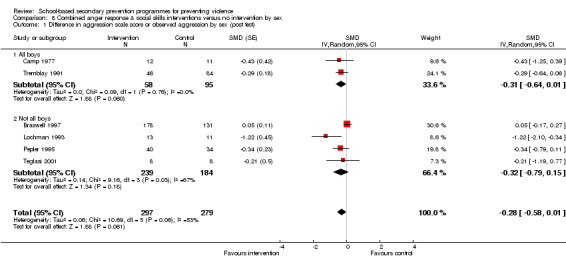
Comparison 8 Combined anger response & social skills interventions versus no intervention by sex, Outcome 1 Difference in aggression scale score or observed aggression by sex (post test).
8.2. Analysis.
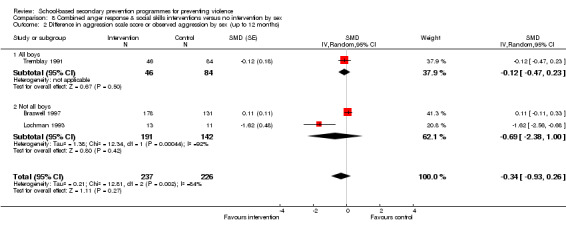
Comparison 8 Combined anger response & social skills interventions versus no intervention by sex, Outcome 2 Difference in aggression scale score or observed aggression by sex (up to 12 months).
8.3. Analysis.
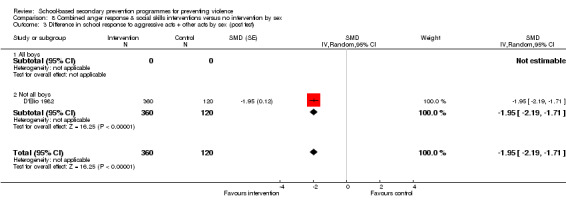
Comparison 8 Combined anger response & social skills interventions versus no intervention by sex, Outcome 3 Difference in school response to aggressive acts + other acts by sex (post test).
Comparison 9. Any intervention versus no intervention with and without imputed standard deviations.
| Outcome or subgroup title | No. of studies | No. of participants | Statistical method | Effect size |
|---|---|---|---|---|
| 1 Difference in aggression (score or observed) by type of school without imputed SDs | 29 | 2807 | SMD (Random, 95% CI) | ‐0.34 [‐0.48, ‐0.19] |
| 1.1 Primary school | 19 | 2297 | SMD (Random, 95% CI) | ‐0.34 [‐0.51, ‐0.16] |
| 1.2 Secondary school | 10 | 510 | SMD (Random, 95% CI) | ‐0.34 [‐0.62, ‐0.06] |
| 2 Difference in aggression (score or observed) by type of school ‐ imputed SDs only | 5 | 132 | SMD (Random, 95% CI) | ‐1.03 [‐1.40, ‐0.66] |
| 2.1 Primary school | 3 | 78 | SMD (Random, 95% CI) | ‐1.25 [‐1.74, ‐0.76] |
| 2.2 Secondary school | 2 | 54 | SMD (Random, 95% CI) | ‐0.75 [‐1.31, ‐0.19] |
9.1. Analysis.
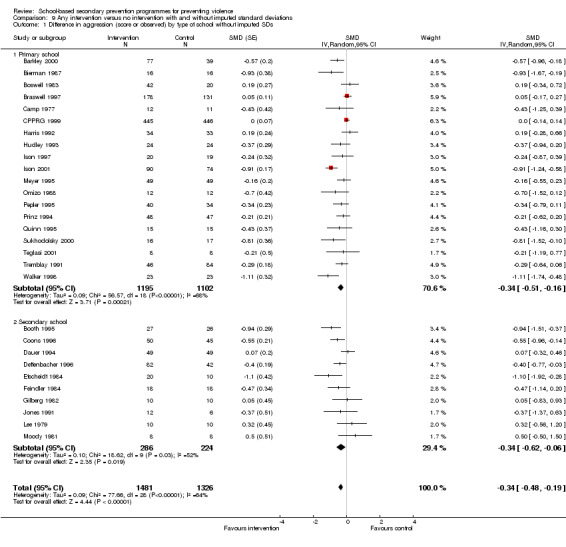
Comparison 9 Any intervention versus no intervention with and without imputed standard deviations, Outcome 1 Difference in aggression (score or observed) by type of school without imputed SDs.
9.2. Analysis.
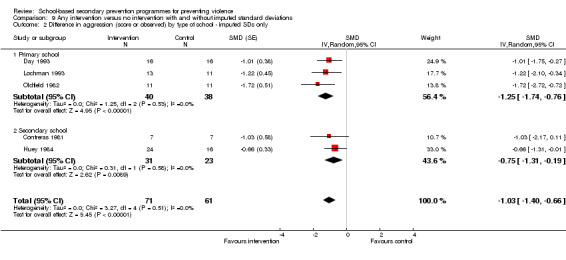
Comparison 9 Any intervention versus no intervention with and without imputed standard deviations, Outcome 2 Difference in aggression (score or observed) by type of school ‐ imputed SDs only.
Comparison 10. Any intervention versus no intervention sensitivity analysis for cluster adjustments.
| Outcome or subgroup title | No. of studies | No. of participants | Statistical method | Effect size |
|---|---|---|---|---|
| 1 Difference in aggression (score or observed) by type of school ‐ ICC=0.1 | 34 | 2939 | SMD (Random, 95% CI) | ‐0.42 [‐0.57, ‐0.26] |
| 1.1 Primary school | 22 | 2375 | SMD (Random, 95% CI) | ‐0.43 [‐0.61, ‐0.24] |
| 1.2 Secondary school | 12 | 564 | SMD (Random, 95% CI) | ‐0.41 [‐0.67, ‐0.14] |
| 2 Difference in aggression (score or observed) by type of school ‐ ICC=0.2 | 34 | 2939 | SMD (Random, 95% CI) | ‐0.41 [‐0.56, ‐0.26] |
| 2.1 Primary school | 22 | 2375 | SMD (Random, 95% CI) | ‐0.42 [‐0.61, ‐0.24] |
| 2.2 Secondary school | 12 | 564 | SMD (Random, 95% CI) | ‐0.39 [‐0.64, ‐0.14] |
10.1. Analysis.
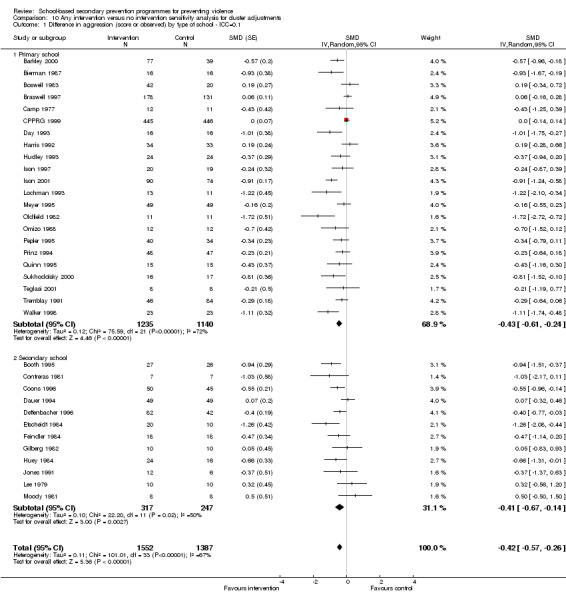
Comparison 10 Any intervention versus no intervention sensitivity analysis for cluster adjustments, Outcome 1 Difference in aggression (score or observed) by type of school ‐ ICC=0.1.
10.2. Analysis.
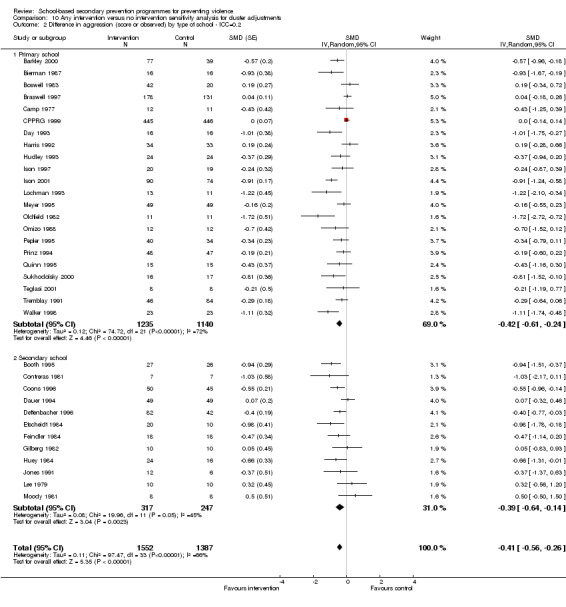
Comparison 10 Any intervention versus no intervention sensitivity analysis for cluster adjustments, Outcome 2 Difference in aggression (score or observed) by type of school ‐ ICC=0.2.
Comparison 11. Sensitivity analysis for cluster adjustments.
11.1. Analysis.

Comparison 11 Sensitivity analysis for cluster adjustments, Outcome 1 ICC=0.1.
11.2. Analysis.

Comparison 11 Sensitivity analysis for cluster adjustments, Outcome 2 ICC=0.2.
Characteristics of studies
Characteristics of included studies [ordered by study ID]
Arbuthnot 1986.
| Methods | Rank ordered for severity of problems, matched in pairs, Pairs allocated by coin toss. | |
| Participants | 48 grade 7‐10 students, teacher nominated on basis of behaviour. | |
| Interventions | I: Moral dilemma discussion group (45 minutes per week for 16‐20 weeks) C: No intervention. | |
| Outcomes | (1) Moral judgement interview (2) *School adjustment index , teacher (blinding unclear) (3) *Disciplinary referrals (4) Frequency of police or court contacts (5) School absenteeism or tardiness (6) School grades. | |
| Notes | Post testing data collection during the last 2 months of intervention and following 1 month. Follow up data collection during the 9 month school year following the intervention. | |
| Risk of bias | ||
| Bias | Authors' judgement | Support for judgement |
| Allocation concealment? | Unclear risk | B ‐ Unclear |
Barkley 2000.
| Methods | Matched for gender, then randomised. Method of randomisation unspecified. Randomisation violated in 8 cases. | |
| Participants | 158 Kindergarten children (aged 4.5 to 6 years) parent rated as being aggressive, impulsive and disruptive. | |
| Interventions | I1: Parent only training (PT) (1 sessions per week for 10 weeks + 2 booster sessions) I2: Special Treatment Classroom (STC) I3: PT & STC C: No Intervention. | |
| Outcomes | Parent ratings (1) CBCL (2) Home situations questionnaire (3) Normative adaptive behavior checklist. Teacher ratings: (4) *CBCL‐TRF (unblinded) (5) School situations questionnaire (6) Self‐control rating scale (7) Social skills rating scale. (8) Clinic behavioural observations (9) Classroom observed behaviour. | |
| Notes | Data collection post treatment and at 2 years. | |
| Risk of bias | ||
| Bias | Authors' judgement | Support for judgement |
| Allocation concealment? | High risk | C ‐ Inadequate |
Bienert 1995.
| Methods | Randomisation by computer generated table of random numbers. | |
| Participants | 78 grade 6 students scoring <=1 SD below mean for Peer Likeability Scale and identified as aggressive‐ disruptive or sensitive‐ isolated on the Minnesota Revised Class Play. | |
| Interventions | I: Deficit specific social skills training (60 minutes per week for 10 weeks). C: no intervention. | |
| Outcomes | (1) Peer rating of likeability scale (2) *Minnesota revised class play (blinding unclear) (3) Perceived self confidence scale (4) Teacher skills checklist. | |
| Notes | Data collection at 0 and 6 months. | |
| Risk of bias | ||
| Bias | Authors' judgement | Support for judgement |
| Allocation concealment? | Unclear risk | B ‐ Unclear |
Bierman 1987.
| Methods | Randomisation unspecified. | |
| Participants | 32 boys in grades 1‐3 peer nominated for negative behaviour. | |
| Interventions | I1: Social skills training with reward reinforcement (10 x 30 minute sessions) I2: Rule giving and reward reinforcement (10 x 30 minute sessions) I3: I1 + I2 (10 x 30 minute sessions) C: No intervention | |
| Outcomes | (1) *Behavioural observations (independent observers) (blinded) (2) Pupil Evaluation inventory (Peers & teachers) (3) Conners abbreviated teachers rating scale (4) Sociometric scale (Peers) | |
| Notes | Data collection at 0 and 6 weeks. | |
| Risk of bias | ||
| Bias | Authors' judgement | Support for judgement |
| Allocation concealment? | Unclear risk | B ‐ Unclear |
Booth 1995.
| Methods | Randomisation unspecified. | |
| Participants | 53 grade 6‐8 students with repeated principal referrals and suspensions for aggressive behaviour. | |
| Interventions | I: Group anger control training. (12 x 45 minute sessions). C: Usual school services (access to counseling and referral if required) | |
| Outcomes | (1) *Achenbach Child Behavior Checklist (CBCL) ‐ Teacher Report Form (TRF) (unblinded) (2) Youth Self Report Form (3) *Disciplinary referrals (4) Student Evaluation Inventory. | |
| Notes | Data collected at 1 week and 4 months. | |
| Risk of bias | ||
| Bias | Authors' judgement | Support for judgement |
| Allocation concealment? | Unclear risk | B ‐ Unclear |
Boswell 1983.
| Methods | Randomisation unspecified. 4 boys put in intervention group on request of school counsellor. | |
| Participants | 62 grade 3‐6 boys referred by teacher to school counsellor due to anger control problems. | |
| Interventions | I1: Anger management training. (2 session per week for 5 weeks, or 1 session per week for 10 weeks) I2: Stress innoculation training. C: No intervention | |
| Outcomes | (1) *Miller School Behavior Checklist , teacher (blinded) (2) Imaginal & Role Play anger provoking situations (3) Rosenweig Picture Frustration Study | |
| Notes | Timing of data collection unclear. | |
| Risk of bias | ||
| Bias | Authors' judgement | Support for judgement |
| Allocation concealment? | High risk | C ‐ Inadequate |
Braswell 1997.
| Methods | Cluster randomisation of matched school districts. Method of randomisation unspecified. | |
| Participants | 309 grade 1‐4 students scored as >1.75SD above norm on the Conners Hyperactivity Index. | |
| Interventions | I1: Minnesota Competence Enhancement Intervention. Children taught social skills, anger management & conflict resolution (18 x 45 minute session in year 1 , 10 sessions in year 2) + Parent training (9 x 120 minute sessions in year 1 & 6 sessions in year 2) + Teacher training (2 x 120 + 9 x 45 minute sessions in year 1 & 1 x 120 + 5 x 45 minute sessions in year 2). C: No intervention for children. Teachers and parents had information sharing sessions. | |
| Outcomes | (1) *Behavioural Assessment System for Children (BASC) ‐ Externalising problems ‐Teacher form (blinding unclear) (2) BASC ‐ Externaling problems ‐ Parent form (3) Self Report of Personality Scale (4) Conners Teacher Rating Scale ‐ hyperactivity index (5) Problem Solving Rating Scale (PSRS) ‐ Teachers form (6) PSRS ‐ Parents form (7) Structured Behavioural Observations | |
| Notes | Data collected immediately and at 12 months. Published data adjusted for cluster randomisation. | |
| Risk of bias | ||
| Bias | Authors' judgement | Support for judgement |
| Allocation concealment? | Unclear risk | B ‐ Unclear |
Camp 1977.
| Methods | Randomisation by drawing names from a bag | |
| Participants | 23 grade 2 boys scored by teacher as >= 2 SD above norm on aggressive subscale of Miller School Behavior Checklist | |
| Interventions | I1: Think Aloud program to improve self control. (1 x 30 minute session daily for 6 weeks) C: No intervention | |
| Outcomes | (1) *Miller School Behavior Checklist ‐ aggressive subscale, teacher (unblinded) | |
| Notes | Data collected up to 3 weeks | |
| Risk of bias | ||
| Bias | Authors' judgement | Support for judgement |
| Allocation concealment? | Unclear risk | B ‐ Unclear |
Camp 1980.
| Methods | Randomisation by coin toss | |
| Participants | 63 grade 1‐2 boys scored by teachers >=65 on aggressive subscale of School Behavior Checklist | |
| Interventions | I1: Think Aloud program + delayed refresher program (1 x 30 minute session daily for 8 weeks + 3 sessions per week for 1 month) I2: Great Expectations program + refresher program. | |
| Outcomes | (1) Observed classroom behaviour (2) *Miller School Behavior Checklist , teacher (blinded) | |
| Notes | Data collected immediately after intervention and refresher program | |
| Risk of bias | ||
| Bias | Authors' judgement | Support for judgement |
| Allocation concealment? | Unclear risk | B ‐ Unclear |
Cavell 2000.
| Methods | Randomisation unspecified, but participants blocked by grade | |
| Participants | 62 grade 2‐3 students, teacher nominated & scoring >=84th centile on CBCL ‐ aggression subscale | |
| Interventions | I1: Therapeutic mentoring + parent & teacher consultation (weekly contact for 16 months) + problem solving skills training (2 x 30 minute sessions per week for 23 weeks) I2: Standard mentoring (Minimum of 1 hour per week for 16 months) | |
| Outcomes | (1) CBCL ‐ parent form (2) *CBCL‐TRF aggression subscale (blinding unclear) (3) Peer rated aggression | |
| Notes | Data collected at end of intervention and 1 year follow up | |
| Risk of bias | ||
| Bias | Authors' judgement | Support for judgement |
| Allocation concealment? | Unclear risk | B ‐ Unclear |
Coats 1979.
| Methods | Randomisation unspecified | |
| Participants | 16 grade 3 boys selected on observation and teacher nominated for aggression, impulsivity and poor self control | |
| Interventions | I: Cognitive self instruction training (4 x 30 minutes per week for 2 weeks) P: attention control group, no intervention (4 x 30 minutes per week for 2 weeks) | |
| Outcomes | (1) Classroom behavioural observation scale (2) Conners Behavioural Rating scale ‐ aggression and hyperactivity subscales, teacher (unblinded) (3) Staged problematic situation test | |
| Notes | Data collected immediately post intervention | |
| Risk of bias | ||
| Bias | Authors' judgement | Support for judgement |
| Allocation concealment? | Unclear risk | B ‐ Unclear |
Contreras 1981.
| Methods | Randomisation by computer generated table of random numbers. | |
| Participants | 22 senior high school students previously suspended for aggressive behaviours (11/22 in Special Education, of whom 8 intellectually disabled). | |
| Interventions | I1: Structured life skills program (2 x 60 minute sessions per week for 5 weeks). P: Discussion group of song lyrics. C: No intervention | |
| Outcomes | (1) *Videotape recordings of physical aggression (Independent observers) (blinding unclear)(2) *school suspensions, from school records | |
| Notes | Data collected during last session and at one week. | |
| Risk of bias | ||
| Bias | Authors' judgement | Support for judgement |
| Allocation concealment? | Unclear risk | B ‐ Unclear |
Coons 1996.
| Methods | Randomisation unspecified. | |
| Participants | 95 students aged 12 to 17 randomly selected from a pool displaying at least 3 of: verbal & physical aggression, failing grades, family turmoil, conduct disorder diagnosis and record of arrest. | |
| Interventions | I: Shame reduction group therapy (60 minutes per week for 10 wks) C: no intervention | |
| Outcomes | (1) Internalised shame scale (2) State‐triat Anger Expression Inventory (a) trait anger subscale (b) *Outwardly expressed anger subscale, self report (unblinded) | |
| Notes | Data collection unspecified. | |
| Risk of bias | ||
| Bias | Authors' judgement | Support for judgement |
| Allocation concealment? | Unclear risk | B ‐ Unclear |
CPPRG 1999.
| Methods | Coin toss of matched pairs. Cluster randomisation by school. | |
| Participants | 891 grade 1 students (˜48 schools) scoring highest 10% on Teacher Observation of Classroom Adaptation ‐ Revised (TOCA‐R), and a parent report including the CBCL aggression scale. | |
| Interventions | I: Fast Tract PATHS Curriculum (Promoting Alternative Thinking Strategies) + parent groups + home visiting + academic tutoring. C: No intervention | |
| Outcomes | (1) CBCL ‐ externalising subscale (parent) (2) Parent Daily Report (3) Parent Ratings of Child Behavior Change (4) *CBCL‐TRF (blinding unclear) (5) TOCA‐R (6) Authority Acceptance Scale (teacher) (7) Teacher Ratings of Child Behavior Change (8) Peer nominations of aggressive behavior (9) School observations of aggressive behavior (10) TOCA‐R (observer) (11) *School records of special education use (12) Home behavior (observer) | |
| Notes | Data collected at end of intervention. | |
| Risk of bias | ||
| Bias | Authors' judgement | Support for judgement |
| Allocation concealment? | Unclear risk | B ‐ Unclear |
D'Elio 1982.
| Methods | Randomisation by table of random numbers: open list. | |
| Participants | 480 grade 7‐9 students who in previous year were truant >15 days + referred to Dean >4 times for aggressive or destructive behaviour + suspended from school >2 times for criminal activity or serious aggressive or destructive activity | |
| Interventions | I1: Individual conflict management training (2 x 45 minute sessions per week for 9 months). I2: Family mediation. I3: Peer group conflict management training. C: No intervention | |
| Outcomes | (1) *Disciplinary referrals (2) School suspensions | |
| Notes | Data collected at one month. | |
| Risk of bias | ||
| Bias | Authors' judgement | Support for judgement |
| Allocation concealment? | High risk | C ‐ Inadequate |
Dauer 1994.
| Methods | Randomisation unspecified. | |
| Participants | 98 grade 6‐7 boys nominated by school principal for conduct problems & disciplinary referrals for anger management problems. | |
| Interventions | I: Anger management program (1 x 40 minute session per week for 8 weeks). C: No intervention | |
| Outcomes | (1) *Conners Teacher Rating Scale 39 ‐ conduct problem subscale, teacher (blinded) (2) State‐Trait Anger Expression Inventory (Ax‐O subscale) (3) *Disciplinary referrals | |
| Notes | Data collected at end of intervention. | |
| Risk of bias | ||
| Bias | Authors' judgement | Support for judgement |
| Allocation concealment? | Unclear risk | B ‐ Unclear |
Day 1993.
| Methods | Randomisation by coin toss of matched pairs. | |
| Participants | 32 6‐12 year old students, teacher nominated and scoring >=60 on CBCL‐TRF (externalising subscale). | |
| Interventions | I: Group cognitive skills training (2 x 75 minutes per week for 12 weeks) + Individual coaching (1 x 30 minute session per week for 12 weeks) + Family outreach. School wide social skills training. C: School wide social skills training only | |
| Outcomes | (1) *CBCL‐TRF (unblinded) (2) Olweus Bullying Survey (3) Observed classroom aggression (4) Self report aggression questionnaire | |
| Notes | Data collected at end of intervention. | |
| Risk of bias | ||
| Bias | Authors' judgement | Support for judgement |
| Allocation concealment? | Unclear risk | B ‐ Unclear |
Deffenbacher 1996.
| Methods | Randomisation by table of random numbers. | |
| Participants | 124 grade 6‐8 students scoring >= 75th centile on Spielberger Trait Anger Scale. | |
| Interventions | I1: Cognitive relaxation & coping skills training (9 x 45 minute sessions) I2: Social skills training (9 x 45 minute sessions) C: No intervention | |
| Outcomes | (1) Anger Expression Inventory (Ax‐O subscale) (2i) Deviant behavior rating scale (2ii) *School Deviance Score, self (unblinded) | |
| Notes | Data collected at 8 weeks. | |
| Risk of bias | ||
| Bias | Authors' judgement | Support for judgement |
| Allocation concealment? | Unclear risk | B ‐ Unclear |
Etscheidt 1984.
| Methods | Cluster randomisation by drawing names from a hat. | |
| Participants | 30 grade 6‐12 students from school for chronically disruptive students. | |
| Interventions | I1: Anger control program (12 x 30‐40 minute sessions over 3 weeks) I2: Anger control program with behavioural reinforcement C: No intervention | |
| Outcomes | (1) Self Control Rating Scale (2) *Classroom observations of aggression (Independent observer) (blinded) (3) *School behavior records (teacher) (blinding unclear) Checklist | |
| Notes | Data collected at 3 weeks & 7 weeks. | |
| Risk of bias | ||
| Bias | Authors' judgement | Support for judgement |
| Allocation concealment? | Unclear risk | B ‐ Unclear |
Feindler 1984.
| Methods | Randomisation unspecified. | |
| Participants | 36 students aged 12‐15 attending an in‐school behaviour modification program for children with >=2 suspensions in previous year for offences other than smoking or truancy. | |
| Interventions | I: Anger control training (2 x 50 minute sessions per week spread over 7 weeks for total of 10 sessions) C: No intervention | |
| Outcomes | (1) *Self control rating scale (inverse mean used) (teacher) (blinded) (2i) School suspensions (2ii) *School fines | |
| Notes | Data collected at 5 weeks. | |
| Risk of bias | ||
| Bias | Authors' judgement | Support for judgement |
| Allocation concealment? | Unclear risk | B ‐ Unclear |
Feshbach 1979a.
| Methods | Randomisation by table of random numbers. | |
| Participants | 60 grade 3‐5 students nominated by teacher ratings of aggressive behaviour. | |
| Interventions | I1: Empathy training (cognitive and behavioural) (3 x 60 minute sessions per week for 10 weeks) I2: Empathy training (cognitive only) (180 minutes for 10 weeks) P: Problem solving skills training (90 minutes per week for 10 weeks) C: No intervention | |
| Outcomes | (1) Ratings of aggressive behaviour, teacher (blinding unclear) (2) Classroom observation | |
| Notes | Data collection unclear. | |
| Risk of bias | ||
| Bias | Authors' judgement | Support for judgement |
| Allocation concealment? | Unclear risk | B ‐ Unclear |
Feshbach 1979b.
| Methods | Randomisation by table of random numbers. | |
| Participants | 98 grade 3‐4 students teacher and peer nominated on ratings of social behaviour. | |
| Interventions | I1: Empathy training (cognitive and affective) (90 minutes per week for 10 weeks) P: Problem solving skills training (90 minutes per week for 10 weeks) C: No intervention | |
| Outcomes | Ratings of aggressive behaviour, teacher (blinding unclear). | |
| Notes | Data collected at 0 and 6 months. | |
| Risk of bias | ||
| Bias | Authors' judgement | Support for judgement |
| Allocation concealment? | Unclear risk | B ‐ Unclear |
Forman 1980.
| Methods | Randomisation unspecified. | |
| Participants | 20 grade 3‐5 students referred to school psychologist for aggressive behaviour. | |
| Interventions | I1: Cognitive restructuring group (2 x 30 minute sessions per week for 6 weeks) I2: Response cost program (60 minutes per week for 6 weeks) P: Reading tutoring sessions | |
| Outcomes | (1) *Classroom observations, teacher (unblinded) (2) Devereaux Elementary School Behaviour Rating Scale | |
| Notes | Data collected during last week of intervention. | |
| Risk of bias | ||
| Bias | Authors' judgement | Support for judgement |
| Allocation concealment? | Unclear risk | B ‐ Unclear |
Garrison 1982.
| Methods | Randomisation unspecified. | |
| Participants | 30 grade 3‐5 boys with highest teacher ratings on CBCL anger scale, not already receiving psychological services or remedial education. | |
| Interventions | I: Affective imagery training (3 x 30‐40 minute sessions over 1 week) P: Attention group (35 minute sessions for 3 sessions) C: No intervention | |
| Outcomes | (1) *Behaviour checklist ‐ arguing subscale, teacher (blinded) | |
| Notes | Data collected post intervention. | |
| Risk of bias | ||
| Bias | Authors' judgement | Support for judgement |
| Allocation concealment? | Unclear risk | B ‐ Unclear |
Gilberg 1982.
| Methods | Randomisation unspecified. | |
| Participants | 30 grade 7‐12 boys identified by teacher and school counsellor as aggressive. | |
| Interventions | I: Cognitive role taking training (1 x 60 minute session per week for 8 weeks) P: Story telling (60 minutes per week for 8 weeks) C: No intervention | |
| Outcomes | (1) *CBCL‐TRF (blinded) (2) Classroom observation | |
| Notes | Data collected at 2 weeks. | |
| Risk of bias | ||
| Bias | Authors' judgement | Support for judgement |
| Allocation concealment? | Unclear risk | B ‐ Unclear |
Harris 1992.
| Methods | Randomisation unspecified. No more than 2 students in each class were assigned to the experimental condition. | |
| Participants | 67 grade 1‐2 students scoring >70th centile on CBCL‐TRF | |
| Interventions | I1: Psychology consultants worked with teachers to provide behavioural strategies (12 weeks) C: No intervention | |
| Outcomes | (1) *CBCL‐TRF (blinded) | |
| Notes | Data collected immediately. | |
| Risk of bias | ||
| Bias | Authors' judgement | Support for judgement |
| Allocation concealment? | Unclear risk | B ‐ Unclear |
Hudley 1993.
| Methods | Randomisation by table of random numbers. | |
| Participants | 72 grade 3‐5 boys nominated by peers and teachers as aggressive. | |
| Interventions | I: Attributional retraining (2 sessions per week for 6 weeks) P: Thinking skills attention control group (2 sessions per week for 6 weeks) C: No intervention | |
| Outcomes | (1) *Teacher checklist ‐ total aggression subscale (blinded) (2) *Disciplinary referrals | |
| Notes | Data collected immediately (outcome 1) and at 3 months (outcome 2). | |
| Risk of bias | ||
| Bias | Authors' judgement | Support for judgement |
| Allocation concealment? | Unclear risk | B ‐ Unclear |
Hudley 1998.
| Methods | Randomisation by table of random numbers. | |
| Participants | 384 grade 3‐6 boys nominated by peers and teachers as aggressive. | |
| Interventions | I: Attributional retraining (2 x 60 minute sessions per week for 6 weeks) P: Problem solving skills and critical thinking attention control group (120 minutes per week for 6 weeks) C: No intervention | |
| Outcomes | (1) *Disciplinary referrals (2) *Social Skills Rating System ‐ Teacher form (blinded) | |
| Notes | Data collected immediately and at 6 and 12 months. | |
| Risk of bias | ||
| Bias | Authors' judgement | Support for judgement |
| Allocation concealment? | Unclear risk | B ‐ Unclear |
Huey 1984.
| Methods | Randomisation by table of random numbers. | |
| Participants | 48 grade 8‐9 boys referred to the school administrator for chronic classroom disruption. | |
| Interventions | I1: Assertion training (Counselor led) (2 x 60 minute sessions per week for 4 weeks) I2: Assertion training (Peer led) (same duration) P1: Discussion group (Counselor led) (2 x 60 minute sessions per week for 4 weeks) P2: Discussion group (Peer led) (same duration) C: No intervention | |
| Outcomes | (1) Behaviour Role Play test (2) Hand Test (3) *Walker Problem Behavior Identification Checklist (teacher) (blinding unclear) | |
| Notes | Data collected immediately. | |
| Risk of bias | ||
| Bias | Authors' judgement | Support for judgement |
| Allocation concealment? | Unclear risk | B ‐ Unclear |
Hughes 1992.
| Methods | Randomisation unspecified. | |
| Participants | 20 grade 10‐11 girls enrolled in the schools 'at‐risk' program + teacher nomination + >=2 referrals in preceding year for 'conflict'. | |
| Interventions | I1: Conflict management training (one school day) I2: Conflict management discussion (2 hours) | |
| Outcomes | (1) *CBCL‐TRF (Blinding unclear) (2) Rating scale of classroom behaviour (3) *Disciplinary referrals | |
| Notes | Data collected at 2 weeks. | |
| Risk of bias | ||
| Bias | Authors' judgement | Support for judgement |
| Allocation concealment? | Unclear risk | B ‐ Unclear |
Hughes 1993.
| Methods | Randomisation by table of random numbers (but children in same family or classroom assigned to same condition). | |
| Participants | 51 grade 2‐3 students nominated by teacher as aggressive and scoring >=84th centile on aggression and/or hostile isolation subscale of Miller School Behavior Checklist. | |
| Interventions | I1: Problem solving skills training (2 x 45 minute sessions per week for 10 weeks). I2: Teacher consultations (4 x 30 minute sessions over 6 weeks) | |
| Outcomes | (1) Breyer's Behavior Observation Schedule (2) CBCL (3) *Miller School Behavior Checklist ‐ aggression subscale, teacher (blinding unclear) (4) Revised Class Play | |
| Notes | Data collected immediately. | |
| Risk of bias | ||
| Bias | Authors' judgement | Support for judgement |
| Allocation concealment? | High risk | C ‐ Inadequate |
Ison 1997.
| Methods | Randomisation by coin toss. | |
| Participants | 39 boys aged 7‐12 with scores >150 on Self control rating scale and >75th percentile on each factor in the Child Behavior Report. | |
| Interventions | I1: Social skills training (1 x 30 minute sessions per week for 14 weeks C: No intervention | |
| Outcomes | (1) Self control rating scale (teacher, blinding unclear) (2) *Child behavior report ‐ aggression subscale (Teacher, blinding unclear) (3) Child behaviour scenario (self completed) | |
| Notes | Data collection timing unclear. | |
| Risk of bias | ||
| Bias | Authors' judgement | Support for judgement |
| Allocation concealment? | Unclear risk | B ‐ Unclear |
Ison 2001.
| Methods | Randomisation by coin toss. | |
| Participants | 164 students aged 8‐12 with scores >150 on Self control rating scale and >75th percentile on each factor in the Child Behavior Report. | |
| Interventions | I: Social skills training (2 x 30 minute sessions per week for 7 weeks C: No intervention | |
| Outcomes | (1) Self control rating scale (teacher, blinding unclear) (2) *Child behavior report ‐ aggression subscale (Teacher, blinding unclear) (3) Child behaviour scenario (self completed) | |
| Notes | Data collection timing unclear. | |
| Risk of bias | ||
| Bias | Authors' judgement | Support for judgement |
| Allocation concealment? | Unclear risk | B ‐ Unclear |
Jones 1991.
| Methods | Randomisation by drawing names from a hat (matched for sex). | |
| Participants | 18 year 8‐9 students with highest score on CBCL aggression subscale (adolescents scale). | |
| Interventions | I1: Aggression replacement training (structured learning + anger management + moral reasoning training) (3 x 60 minute session per week for 10 weeks). I2: Moral reasoning training (1 x 60 minute session per week for 10 weeks). C: No intervention | |
| Outcomes | (1) *Behaviour Incident Reports ‐ aggressive subscale, teacher (blinded) (2) Self control/impulsivity scale | |
| Notes | Data collected immediately. | |
| Risk of bias | ||
| Bias | Authors' judgement | Support for judgement |
| Allocation concealment? | Unclear risk | B ‐ Unclear |
Lazerson 1980.
| Methods | Randomisation unspecified. | |
| Participants | 60 grade 2‐8 students referred by teacher as aggressive and withdrawn, and verified by school counselor. | |
| Interventions | I1: Tutor training (2 sessions) then tutoring for 20‐30 minutes, 23 sessions over 5 weeks I2: Receipt of tutoring, as above C: No intervention | |
| Outcomes | (1) Self concept scale (self, unblinded) (2a) *Devereaux Elementary School Behavior rating scale (DESB) aggressive subscale (teacher, unblinded) (2b) DESB withdrawn subscale (teacher, unblinded) | |
| Notes | Data collected post intervention. | |
| Risk of bias | ||
| Bias | Authors' judgement | Support for judgement |
| Allocation concealment? | Unclear risk | B ‐ Unclear |
Lee 1979.
| Methods | Randomisation unspecified. | |
| Participants | 30 grade 9 students selected by peers as aggressive. | |
| Interventions | I: Assertion training (1 x 50 minute session per week for 8 weeks). P: Decion making group (50 minutes per week for 8 weeks) C: No intervention | |
| Outcomes | (1) *Peer Aggression Rating Scale, peers (blinding unclear) (2) Self‐report Aggression Rating Scale | |
| Notes | Data collected at 1 week. | |
| Risk of bias | ||
| Bias | Authors' judgement | Support for judgement |
| Allocation concealment? | Unclear risk | B ‐ Unclear |
Lochman 1993.
| Methods | Randomisation unspecified. | |
| Participants | 24 grade 3 students nominated by peers as least liked and most likely to fight. | |
| Interventions | I: Social problem solving skills training (26 x 30 minute individual sessions + 8 group sessions, 2 per week for 6 months). C: No intervention | |
| Outcomes | (1) *Teacher Behavior Check List ‐ aggression subscale (unblinded at post test, blinded at follow‐up) (2) Peer nomination screening ‐ aggression subscale | |
| Notes | Data collected immediately and at 12 months. | |
| Risk of bias | ||
| Bias | Authors' judgement | Support for judgement |
| Allocation concealment? | Unclear risk | B ‐ Unclear |
MACS 2002.
| Methods | Cluster randomisation by random number draw. | |
| Participants | 2181 students in grades 2,3,5 & 6 selected by teacher and peer nominations. | |
| Interventions | I1: Family relationship intervention (1 x 60‐90 minute session per week for 22 weeks) + I2 + C1. I2: Peer relationship training (1 x 60 minute session per week for 10 weeks in year 1 & 16 weeks in year 2) + C1. C1: Classroom prosocial skills training (2 x 60 minute sessions per week, 20 sessions per year, for 2 years). C2: No intervention | |
| Outcomes | (1) Peer nomination Index (2) CBCL‐TRF (blinding unclear) (3) Classroom observation of on‐task behaviour (4) Delinquency questionnaire (5) Court record attendances | |
| Notes | Data collected immediately and annually. | |
| Risk of bias | ||
| Bias | Authors' judgement | Support for judgement |
| Allocation concealment? | Unclear risk | B ‐ Unclear |
Meyer 1995.
| Methods | Randomisation by table of random numbers. | |
| Participants | 120 grade 4‐6 students referred to school principal on more than one occasion for inappropriate behaviour. | |
| Interventions | I: Peer mediation training (conflict resolution training) (2 days training + use of skills over 12 weeks). C: Use of peer mediation | |
| Outcomes | (1) Self Perception Profile for Children (SPPC) ‐ Behavioural conduct subscale (2) *SPPC ‐ Teacher rating scale (blinding unclear) (3) *Disciplinary referrals | |
| Notes | Data collected during 12 weeks after training. | |
| Risk of bias | ||
| Bias | Authors' judgement | Support for judgement |
| Allocation concealment? | Unclear risk | B ‐ Unclear |
Moody 1981.
| Methods | Randomisation by table of random numbers. | |
| Participants | 22 grade 7‐8 boys having >= 3 tally marks for aggressive behaviour from teacher during a 1 week observation period. | |
| Interventions | I: Assertion training (2 x 45 minute sessions per week for 5 weeks). P: Group counseling (Communication skills and decision making) (90 minutes per week for 5 weeks) C: No intervention | |
| Outcomes | (1) *Pittsburgh Adjustment Survey Scale ‐ aggressive behaviour subscale, teacher (blinding unclear) (2) Sears Aggression Scale (3) Teachers tally sheet | |
| Notes | Data collected at 1 week. | |
| Risk of bias | ||
| Bias | Authors' judgement | Support for judgement |
| Allocation concealment? | Unclear risk | B ‐ Unclear |
Newton 1994.
| Methods | Stratified random allocation (rank ordered for scores). Method unspecified. | |
| Participants | 48 grade 7‐8 students scoring > median in 2/3 of Violent Incidents, Violence Scale Score (reflects severity of violent incidents) and Violence Index Score (indicates likelihood of referrals being for violence). | |
| Interventions | I: Mentor program (minimum of 1 hour of contact per week between mentor and student for 1 semester) C: No mentoring, but allowed to participate in other school programs designed to improve behaviour, self esteem and academic performance | |
| Outcomes | (1) School exclusions (2) Violence Scale Score (3) *Violence Index | |
| Notes | Data collected during the mentoring period. | |
| Risk of bias | ||
| Bias | Authors' judgement | Support for judgement |
| Allocation concealment? | Unclear risk | B ‐ Unclear |
Oldfield 1982.
| Methods | Randomisation by drawing names from a box. | |
| Participants | 22 grade 4‐6 students with >=10 incidents of violent or aggressive behaviour during a 25 day observation period. 3 students had learning difficulties. | |
| Interventions | I: Meditation training (90 minutes of training over 2 sessions, practiced daily for 10‐20 minutes for 80 days). P: Behaviour charting training (90 minutes training then 15 minutes daily use for 80 days) | |
| Outcomes | (1) *Violent/Aggressive Incident Form, teacher (blinded) (2) Rosenweig picture Frustration Study | |
| Notes | Data collected during last 25 days of intervention. | |
| Risk of bias | ||
| Bias | Authors' judgement | Support for judgement |
| Allocation concealment? | Unclear risk | B ‐ Unclear |
Omizo 1988.
| Methods | Randomisation by table of random numbers. | |
| Participants | 24 grade 4‐6 students nominated by teacher as aggressive or hostile. | |
| Interventions | I: Counseling sessions (cognitive behavioural techniques) (1 x 45 minute session per week for 10 weeks). P: Watched films (1 x 45 minute session per week for 10 weeks). | |
| Outcomes | (1) *Miller School Behavior Checklist ‐ aggression and hostile isolation subscales, teacher (blinded) | |
| Notes | Data collected at one week after intervention. | |
| Risk of bias | ||
| Bias | Authors' judgement | Support for judgement |
| Allocation concealment? | Unclear risk | B ‐ Unclear |
Pepler 1995.
| Methods | Randomisation unspecified. | |
| Participants | 74 grade 1‐6 students referred to a program for aggressive behaviour, disruption or non‐compliance over a 2 year period, following teacher nomination. | |
| Interventions | I: Social Skills training (including some components of the 'Think Aloud' program) (2 x 75 minute sessions per week for 12‐15 weeks). C: No intervention | |
| Outcomes | (1) CBCL ‐ Parents (2) *CBCL‐TRF (blinding unclear) (3) Revised Class Play | |
| Notes | Data collected immediately. | |
| Risk of bias | ||
| Bias | Authors' judgement | Support for judgement |
| Allocation concealment? | Unclear risk | B ‐ Unclear |
Petit 1998.
| Methods | Randomisation unspecified (Intention to treat analysis not maintained). | |
| Participants | 90 grade 9‐12 students randomly selected from those assigned to alternative education programme for infractions of school discipline policy. | |
| Interventions | I: Anger management + life skills training 50 minutes 2 x per week for 9 weeks P: No intervention watched educational videos with no anger management information C: No intervention | |
| Outcomes | (1) State trait Anger Expression Inventory (participant, unblinded) (2) *CBCL‐TRF (teacher, blinding unclear) (3) Positive behaviour survey (teacher, blinding unclear) | |
| Notes | Data collected immediately. | |
| Risk of bias | ||
| Bias | Authors' judgement | Support for judgement |
| Allocation concealment? | High risk | C ‐ Inadequate |
Pietrucha 1998.
| Methods | Stratified by peer status. Randomisation unspecified. | |
| Participants | 32 grade 4‐6 students peer selected as aggressive and not accepted, and self reported behavioural responses to provocation vignettes. | |
| Interventions | I: Social goal modification program 45‐60 minutes per week for 8 weeks P: Recreational activities 45‐60 minutes per week for 8 weeks C: No intervention | |
| Outcomes | (1) Ambiguous provocation vignettes (self) (2) Outcome values questionnaire (self) (3) Legitimacy of aggressive beliefs (self) (4) Peer behaviour nominations (blinding unclear) (5) Peer acceptance (blinding unclear) (6) *Teacher behaviour checklist (Coie) (Blinded) (7) Weshler IQ | |
| Notes | Data collected immediately and at 2 months. | |
| Risk of bias | ||
| Bias | Authors' judgement | Support for judgement |
| Allocation concealment? | Unclear risk | B ‐ Unclear |
Prinz 1994.
| Methods | Cluster randomisation using coin toss. | |
| Participants | 25 grade 1‐3 classes randomised, 95 students scoring >= 65 on aggressive subscale of CBCL‐TRF , and 101 scoring <=60 on aggressive subscale and >median on communication effectiveness subscale. | |
| Interventions | I: Peer coping skills training (1 x 50 minute session per week for 19‐24 weeks) + Minimal classroom intervention ( a class wide program to promote prosocial behaviour). C: Minimal classroom intervention only | |
| Outcomes | (1) *CBCL‐TRF aggression subscale (unblinded) | |
| Notes | Data collected immediately and at 6 months. | |
| Risk of bias | ||
| Bias | Authors' judgement | Support for judgement |
| Allocation concealment? | Unclear risk | B ‐ Unclear |
Quinn 1995.
| Methods | Randomisation by coin toss. | |
| Participants | 30 7 year old students identified by teachers as aggressive on CBCL‐TRF aggressive subscale, with poor academic engagement and playground activity and nominated by teachers as at risk of antisocial behaviour. | |
| Interventions | I: Co‐operative learning (Interpersonal problem solving skills) (26 x 20 minute sessions over 6 weeks). C: No intervention | |
| Outcomes | (1) Systematic Screening for Behavior Disorders (2) *CBCL‐TRF aggression subscale (blinding unclear) | |
| Notes | Data collection period unspecified. | |
| Risk of bias | ||
| Bias | Authors' judgement | Support for judgement |
| Allocation concealment? | Unclear risk | B ‐ Unclear |
Sackles 1981.
| Methods | Randomisation unspecified. | |
| Participants | 35 grade 6‐8 students scoring >= 1 SD above mean on Anger Inventory Scale (modified) | |
| Interventions | I1: Stress innoculation (1 x 45 minute session per week for 8 weeks). I2: Interpersonal cognitive problem solving. I3: Assertiveness training (45 minutes per week for 8 weeks) C: No intervention | |
| Outcomes | (1) Anger Inventory Scale (2) *Devereux Behavior Rating Scale, teacher (blinding unclear) (3) Laboratory provacation situations (4) Self report measure of anger | |
| Notes | Data collection period unspecified. | |
| Risk of bias | ||
| Bias | Authors' judgement | Support for judgement |
| Allocation concealment? | Unclear risk | B ‐ Unclear |
Sukhodolsky 2000.
| Methods | Randomisation unspecified. Randomisation broken for 3 boys due to scheduling problems. | |
| Participants | 33 grade 4‐5 boys teacher nominated for anger related problems. | |
| Interventions | I: Cognitive‐ behavioral anger control group therapy (40 minutes per week for 10 weeks) P: play activities + control of inappropriate behaviours by reward | |
| Outcomes | (1) Pediatric anger expression scale (self) (2) Children's inventory of anger (self) (3) *Teacher Rating Scale (Finch) (teacher, blinded) | |
| Notes | Data collected immediately post intervention. | |
| Risk of bias | ||
| Bias | Authors' judgement | Support for judgement |
| Allocation concealment? | High risk | C ‐ Inadequate |
Tanner 1988.
| Methods | Randomisation blocked by sex and grade, method unspecified. | |
| Participants | 24 grade 1‐3 students nominated by teachers as having aggressive features during previous 6 months. | |
| Interventions | I: Assertiveness social skills training (2 x 60 minute sessions per week for 3 weeks). P: Attention control group (120 minutes per week for 3 weeks) | |
| Outcomes | (1) *Revised Parents Inventory of Childrens Skills, teacher (blinded) (2) Behavioural observations during (a) free play (b) structured test (c) transport home | |
| Notes | Data collected immediately. | |
| Risk of bias | ||
| Bias | Authors' judgement | Support for judgement |
| Allocation concealment? | Unclear risk | B ‐ Unclear |
Teglasi 2001.
| Methods | Randomisation unspecified. | |
| Participants | 17 grade 4‐5 students teacher nominated for disruptive, hostile and intrusive behaviour. | |
| Interventions | I: STORIES program [social skills training + social problem solving + pretest] (60 minutes per week for 15 weeks) C: No intervention and no pretest | |
| Outcomes | (1) *Composite of BASC ‐ Behavioral Assessment System for Children ‐ externalising subscale and School Social Behavior Scale ‐ antisocial behavior subscale (teacher, unblinded) (2) NOBAG ‐ Normative Beliefs about Aggression (self) (3) Treatment ‐ Response Index (researcher, unblinded) | |
| Notes | Data collected post intervention. | |
| Risk of bias | ||
| Bias | Authors' judgement | Support for judgement |
| Allocation concealment? | Unclear risk | B ‐ Unclear |
Tremblay 1991.
| Methods | Randomisation using computer generated table of random numbers. | |
| Participants | 172 kindergarten boys scoring >=70% on a preschool behaviour questionnaire for disruptive behaviour. | |
| Interventions | I: Social skills training (9 sessions in year 1, 10 sessions in year 2) + Parents training (mean contact 17.4 sessions) + Fantasy training (25/46) (12 sessions) + Critical TV viewing (9/46) (9 sessions). C: No intervention | |
| Outcomes | (1) *Social Behavior Questionnaire (SBQ) ‐ Teacher completed (unblinded) (2) SBQ ‐ Mother completed (3) Pupil Evaluation Inventory (4) Misbehaviour Questionnaire (5) *Violent delinquency at age 16/17 | |
| Notes | Data collected immediately, and at 1,2,6 & 7 years. | |
| Risk of bias | ||
| Bias | Authors' judgement | Support for judgement |
| Allocation concealment? | Unclear risk | B ‐ Unclear |
Walker 1998.
| Methods | Randomisation unspecified. | |
| Participants | 46 kindergarten to grade 2 students nominated by teacher and scoring high on CBCL‐TRF and low on Academic Engaged Time scale. | |
| Interventions | I: Teacher training (Praise, points and rewards) (2 x 20 minute sessions per day for 30 days) + Parent training (Lessons, guidelines and games) (6 x 60 minute sessions). C: No intervention | |
| Outcomes | (1) Teacher ratings of maladaptive behaviour (2) *CBCL‐TRF aggression subscale (blinded) | |
| Notes | Data collected immediately and at 12 months. | |
| Risk of bias | ||
| Bias | Authors' judgement | Support for judgement |
| Allocation concealment? | Unclear risk | B ‐ Unclear |
Duration of intervention is entered in brackets after the intervention. Where there are more than one intervention group, but the duration of intervention is the same for each group, the duration is only entered after the first group. Outcomes preceded with an asterisk, indicate those chosen for data entry to meta‐analysis (not all of these outcome measures had data available for inclusion in the meta‐analysis). Blinding (indicated in notes column) relates to the outcomes included in the meta‐analysis only.
Characteristics of excluded studies [ordered by study ID]
| Study | Reason for exclusion |
|---|---|
| August 2001 | Author stated to be primarily a community based programme. The school component of a multicomponent intervention is a summer school intervention, i.e. not delivered during the normal school routine. |
| Blue 1982 | Unable to confirm whether allocation to intervention and control groups was random, and whether the intervention was school based. Unable to contact author. |
| Dubow 1987 | Randomisation method poor. |
| DuRant 1996 | Cluster randomisation of 2 schools. N = 2 studies excluded. |
| Gottfredson 1986 | Excluded due to primary focus on delinquency prevention and not aggression. |
| Gottfredson 1987 | Excluded due to primary focus on delinquency prevention and not aggression. |
| King 1990 | A randomised controlled trial to assess a social development program. Unable to contact author to determine eligibility as a violence prevention programme. Published data collapsed groups, losing randomisation. |
| Larson 1992 | Cluster randomisation of 2 classes. N = 2 studies excluded. |
| Lochman 1985 | Subjects were allocated to groups quasi‐randomly, using alternation. |
| Lochman 2002 | Intervention primarily designed to reduce substance use. |
| Mason 1997 | Subjects were allocated to groups quasi‐randomly, using alternation. |
| Mayer 1983 | Study designed to reduce vandalism costs and secondly to assess effect on disruptive behaviour. Not designed to reduce violent behaviour. |
| Miller 1990 | 1) Aim of study was to improve moral reasoning, rather than reduction of violent behaviour per se. 2) Personal communication with author to CD indicated that 'randomisation' was in fact by alternation. |
| Smith1991 | Does not contain the terms violence, aggression, bullying, conflict or anger in either the title, abstract or study aims/hypotheses. It is intended to reduce delinquency and disruptive behaviour through improved self esteem. |
Characteristics of ongoing studies [ordered by study ID]
Prinz 2000.
| Trial name or title | The Early Alliance Prevention Trial |
| Methods | |
| Participants | Grade 1 students rated by kindergarten teachers and parents in the top 20% for oppositional aggressive behaviour |
| Interventions | I1: Teacher training in classroom communication & management + classroom 'Good communication game' + targeted group peer relationship training, + reading mentoring + family intervention for high risk children I2: School wide conflict management program |
| Outcomes | (1) Disruptive behaviour disorders scale (parent, unblinded) (2) self report of antisocial behaviour and substance abuse (3) School failure (records, unblinded) |
| Starting date | 1999 |
| Contact information | |
| Notes | Outcomes to be collected at 5 and 8 years |
Teglasi.
| Trial name or title | STORIES program |
| Methods | |
| Participants | Classes of emotionally disturbed children. Cluster randomised, |
| Interventions | I: STORIES program (social skills training + social problem solving) C: No intervention |
| Outcomes | (1) *Composite of BASC ‐ Behavioral Assessment System for Children ‐ externalising subscale and School Social Behavior Scale ‐ antisocial behavior subscale (teacher, unblinded) (2) NOBAG ‐ Normative Beliefs about Aggression (self) (3) Treatment ‐ Response Index (researcher, unblinded) |
| Starting date | 2001 |
| Contact information | |
| Notes |
Contributions of authors
Julie Mytton co‐ordinated the review, was involved in the design of the study and the search strategy, undertook searches, screened search results, appraised the quality of studies, contacted authors, extracted data, entered data to RevMan, analysed and interpreted data and wrote the review.
Carolyn DiGuiseppi was involved in the conception and design of the study, the development of the search strategy, undertook searches, screened search results, appraised the quality of studies, contacted authors, extracted data, contributed to analysis and interpretation of data, and to the drafting and final approval of the text of the review.
David Gough was involved in the screening of papers for inclusion in the study, appraisal of study quality, extraction of data, interpretation of data, and contributed to the drafting and final approval of the text of the review.
Rod Taylor was involved in the analysis of data, provided a methodological perspective on the interpretation of data, and contributed to the drafting and final approval of the text of the review.
Stuart Logan was involved in the conception and design of the study, the interpretation of the data, and contributed to the drafting and final approval of the text of the review.
Sources of support
Internal sources
(JM) Systematic Reviews Training Unit, Institute of Child Health, London, UK.
External sources
(CD) Camden and Islington Health Authority, London, UK.
(CD) US Agency for Healthcare Quality and Research, USA.
Declarations of interest
None known.
Edited (no change to conclusions)
References
References to studies included in this review
Arbuthnot 1986 {published data only}
- Arbuthnot J, Gordon DA. Behavioral and cognitive effects of a moral reasoning development intervention for high‐risk behavior‐disordered adolescents. Journal of Consulting and Clinical Psychology 1986;54(2):208‐16. [DOI] [PubMed] [Google Scholar]
Barkley 2000 {published data only}
- Barkley RA, Shelton TL, Crosswait C, Moorehouse M, Fletcher K, Barrett S, et al. Multi‐method psycho‐educational intervention for preschool children with disruptive behaviour: preliminary results at post‐treatment. Journal of Child Psychology and Psychiatry 2000;41(3):319‐22. [PubMed] [Google Scholar]
- Shelton TL, Barkley RA, Crosswait C, Moorehouse M, Fletcher K, Barrett S, et al. Multimethod psychoeducational intervention for preschool children with disruptive behavior: two‐year post‐treatment follow‐up. Journal of Abnormal Child Psychology 2000;28(3):253‐66. [DOI] [PubMed] [Google Scholar]
Bienert 1995 {published data only}
- Bienert H, Schneider BH. Deficit‐specific social skills training with peer‐nominated aggressive‐disruptive and sensitive‐isolated preadolescents. Journal of Clinical Child Psychology 1995;24(3):287‐99. [Google Scholar]
Bierman 1987 {published data only}
- Bierman KL, Miller CL, Stabb SD. Improving the social behavior and peer acceptance of rejected boys: effects of social skill training with instructions and prohibitions. Journal of Consulting and Clinical Psychology 1987;55(2):194‐200. [DOI] [PubMed] [Google Scholar]
Booth 1995 {published data only}
- Booth BA. A cognitively based anger control training program with aggressive adolescents in the school setting. Dissertation Abstracts International. 56‐07A. New York (NY): State University of New York, 1995; Vol. 56‐07A:2870.
Boswell 1983 {published data only}
- Boswell JW. Effects of a multimodal counseling program and of a cognitive‐behavioral counseling program on the anger management skills of pre‐adolescent boys within an elementary school setting. Dissertation Abstracts International. 45‐01B. Pennsylvania (PN): Pennsylvania State University, 1983; Vol. 45‐01B:372.
Braswell 1997 {published data only}
- Braswell L, August GJ, Bloomquist ML, Realmuto GM, Skare SS, Crosby RD. School‐based secondary prevention for children with disruptive behavior: Initial outcomes. Journal of Abnormal Child Psychology 1997;25(3):197‐208. [DOI] [PubMed] [Google Scholar]
Camp 1977 {published and unpublished data}
- Camp BW, Blom GE, Hebert F, Doorninck WJ. "Think aloud": a program for developing self‐control in young aggressive boys. Journal of Abnormal Child Psychology 1977;5(2):157‐69. [DOI] [PubMed] [Google Scholar]
Camp 1980 {published and unpublished data}
- Camp BW. Two psychoeducational treatment programs for young aggressive boys. In: Whalen CK, Henker B editor(s). Hyperactive children. The social ecology of identification and treatment. New York: Academic Press, 1980. [Google Scholar]
Cavell 2000 {published data only}
- Cavell TA, Hughes JN. Secondary prevention as context for studying change processes in aggressive children. Journal of School Psychology 2000;38:199‐235. [Google Scholar]
Coats 1979 {published data only}
- Coats KI. Cognitive self‐instructional training approach for reducing disruptive behaviour of young children. Psychological Reports 1979;44:127‐34. [DOI] [PubMed] [Google Scholar]
Contreras 1981 {published data only}
- Contreras M. A study of the effectiveness of a structured life skills program in facilitating appropriate classroom behavior. Dissertation Abstracts International. 42‐04B. New Brunswick (NJ): Rutgers University, 1981; Vol. 42‐04B:1583.
Coons 1996 {published data only}
- Coons SR. Shame‐reduction group therapy with conduct disordered adolescents: A self‐psychological approach to understanding aggression and its treatment. Dissertation Abstracts 1996.
CPPRG 1999 {published data only}
- Conduct Problems Prevention Research Group. Initial impact of the Fast Track prevention trial for conduct problems: I. The high‐risk sample. Journal of Consulting and Clinical Psychology 1999;67(5):631‐47. [PMC free article] [PubMed] [Google Scholar]
D'Elio 1982 {published data only}
- D'Elio AR. An investigation of the effectiveness of intervention strategies on juvenile anti‐social behaviors. Dissertation Abstracts International. 43‐05A. New York (NY): Fordham Univ., 1982; Vol. 43‐05A:1466.
Dauer 1994 {published data only}
- Dauer DM. Group counseling for anger control: The effects of an intervention program with middle school students. Dissertation Abstracts International. 55‐03A. Blacksberg (VA): Virginia Polytechnic Institute and State Univ., 1994; Vol. 55‐03A:509.
Day 1993 {published data only}
- Day DM, Hartley L. Evaluating a school‐based program for aggressive children: Comparing outcomes for different levels of service. 101st annual meeting of the American Psychological Association; 1993 Aug 20‐24; Toronto, Canada, 1993.
Deffenbacher 1996 {published data only}
- Deffenbacher JL, Lynch RS, Oetting ER, Kemper CC. Anger reduction in early adolescents. Journal of Counseling Psychology 1996;43(2):149‐57. [Google Scholar]
Etscheidt 1984 {published data only}
- Etscheidt SL. A comparison of cognitive, cognitive‐behavioral and behavioral interventions in reducing classroom aggressive behavior. Dissertation Abstracts International. 46‐01A. Minneapolis (MN): University of Minnesota, 1984; Vol. 46‐01A:120.
Feindler 1984 {published data only}
- Feindler EL, Marriott SA, Iwata M. Group anger control training for junior high school delinquents. Cognitive Therapy and Research 1984;8(3):299‐311. [Google Scholar]
Feshbach 1979a {published data only}
- Feshbach ND. Empathy training: a field study in affective education. In: Feshbach S, Franzek A editor(s). Aggression and behavior change. Biological and social processes. New York: Praeger, 1979. [Google Scholar]
Feshbach 1979b {published data only}
- Feshbach ND. Empathy training: a field study in affective education. In: Feshbach S, Franzek A editor(s). Aggression and behavior change. Biological and social processes. New York: Praeger, 1979. [Google Scholar]
Forman 1980 {published data only}
- Forman SG. A comparison of cognitive training and response cost procedures in modifying aggressive behavior of elementary school children. Behavior Therapy 1980;11(4):594‐600. [Google Scholar]
Garrison 1982 {published data only}
- Garrison SR, Stolberg AL. Modification of anger in children by affective imagery training. Journal of Abnormal Child Psychology 1983;11(1):115‐29. [DOI] [PubMed] [Google Scholar]
Gilberg 1982 {published data only}
- Gilberg JA. The effect of cognitive role‐taking on the classroom behavior of aggressive boys. Dissertation Abstracts International. 43‐06A. College Station (TX): Texas A&M Univ., 1982; Vol. 43‐06A:1889.
Harris 1992 {published data only}
- Harris J, Wilkinson SC, Trovato J, Pryor CW. Teacher‐completed child behavior checklist ratings as a function of classroom‐based interventions: a pilot study. Psychology in the Schools 1992;29:42‐52. [Google Scholar]
Hudley 1993 {published and unpublished data}
- Hudley C, Graham S. An attributional intervention to reduce peer‐directed aggression among African‐American boys. Child Development 1993;64(1):124‐38. [PubMed] [Google Scholar]
Hudley 1998 {published data only}
- Hudley C, Britsch B, Wakefield WD, Smith T, Demorat M, Cho S. An attribution retraining program to reduce aggression in elementary school students. Psychology in the Schools 1998;35(3):271‐82. [Google Scholar]
Huey 1984 {published data only}
- Huey WC, Rank RC. Effects of counselor and peer‐led group assertive training on black adolescent aggression. Journal of Counseling Psychology 1984;31(1):95‐8. [Google Scholar]
Hughes 1992 {published data only}
- Hughes LS. Acquisition of conflict management skills with high school adolescent females. Dissertation Abstracts International. 53‐01A. Kalamazoo (MI); Western Michigan Univ., 1992; Vol. 53‐01A:104.
Hughes 1993 {published data only}
- Hughes JN. Effectiveness of problem solving training and teacher consultation with aggressive children. 101st annual meeting of the American Psychological Association; 1993 Aug 20‐24; Toronto, Canada, 1993.
Ison 1997 {published and unpublished data}
- Ison MS, Rodriguez CI. Social Skills development in the treatment of behavioral disorders in children [Desarrollo de habilidades sociales en el tratamiento de conductas problema infantiles]. Revista Mexicana de Psicologia 1997;14(2):129‐37. [Google Scholar]
Ison 2001 {published data only}
- Ison MS. Written communication. Mendoza, Argentina. Instituto de Ciencias Humanas, Sociales y Ambientales, Centro Regional de Investigaciones Cientificas y Tecnologicas (CRICYT). 2002.
- Ison MS. Training in social skills: an alternative technique for handling disruptive child behavior. Psychological Reports 2001;88:903‐11. [DOI] [PubMed] [Google Scholar]
Jones 1991 {published and unpublished data}
- Jones Y. Aggression replacement training in a high school setting. Australian Journal of Guidance and Counselling 1991;1(1):1‐19. [Google Scholar]
Lazerson 1980 {published data only}
- Lazerson DB. "I must be good if I can teach!" ‐ Peer tutoring with aggressive and withdrawn children. Journal of Learning Disabilites 1980;13(3):43‐8. [DOI] [PubMed] [Google Scholar]
Lee 1979 {published data only}
- Lee DY, Hallberg ET, Hassard JH. Effects of assertion training on aggressive behavior of adolescents. Journal of Counseling Psychology 1979;26(5):459‐61. [Google Scholar]
Lochman 1993 {published data only}
- Lochman JE, Coie JD, Underwood MK, Terry R. Effectiveness of a Social Relations Intervention Program for Aggressive and Nonaggressive, Rejected Children. Journal of Consulting and Clinical Psychology 1993;61:1053‐8. [DOI] [PubMed] [Google Scholar]
MACS 2002 {published data only}
- Guerra NG, Tolan PH, Henry D, Acker R, Huesmann LR, Eron L. Developmental and contextual influences on the prevention of aggression in urban settings: Preliminary outcomes from the Metropolitan Area Child Study. 106th annual meeting of the American Psychological Association; 1998 Aug 14‐18; San Francisco, USA, 1998.
- Metropolitan Area Child Study Research Group. A cognitive‐ecological approach to preventing aggression in urban settings: initial outcomes for high‐risk children. Journal of Consulting and Clinical Psychology 2002;70(1):179‐94. [PubMed] [Google Scholar]
Meyer 1995 {published and unpublished data}
- Meyer RH. The effect of participation in a peer mediation program on the self‐perceptions and conflict style of at‐risk elementary students. Dissertation Abstracts International. 56‐09A. University Park (PA): Pennsylvania State Univ., 1995; Vol. 56‐09A:3457.
Moody 1981 {published data only}
- Moody TJ. The effects of group assertion training on aggressive behaviors of seventh and eighth grade males. Dissertation Abstracts International. 42‐05A. Stillwater (OK): Oklahoma State Univ., 1981; Vol. 42‐05A:1964.
Newton 1994 {published data only}
- Newton FR. A study of the effectiveness of using collegiate mentors to reduce violent behavior, improve self concept, and increase academic success in an urban middle school. Dissertation Abstracts International. 55‐06A. Williamsburg (VA): College of William and Mary in Virginia, 1994; Vol. 55‐06A:1440.
Oldfield 1982 {published data only}
- Oldfield RR. The effects of meditation on selected measures of human potential. Dissertation Abstracts International. 42‐11A. Lincoln (NE): University of Nebraska, 1982; Vol. 42‐11A:4717.
Omizo 1988 {published data only}
- Omizo MM, Hershberger JM, Omizo SA. Teaching children to cope with anger. Elementary School Guidance and Counseling 1988;22(3):241‐5. [Google Scholar]
Pepler 1995 {published data only}
- Pepler D, King G, Craig W, Byrd B, Bream L. The development and evaluation of a multisystem social skills group training program for aggressive children. Child and Youth Care Forum 1995;24(5):297‐313. [Google Scholar]
Petit 1998 {published data only}
- Petit JA. The effects of an anger management program on aggressive adolescents: a cognitive‐behavioral approach. Dissertation, University of New Orleans 1998.
Pietrucha 1998 {published data only}
- Pietrucha CA. A social‐cognitive intervention program: toward the reduction of children's aggressive behavior through modification of social goals. Dissertation, University of Maine 1998.
Prinz 1994 {published data only}
- Prinz RJ, Blechman EA, Dumas JE. An evaluation of peer coping‐skills training for childhood aggression. Journal of Clinical Child Psychology 1994;23(2):193‐203. [Google Scholar]
Quinn 1995 {published data only}
- Quinn MM. Peers as social training agents for young boys with antisocial behavior patterns: Cooperative learning approach. Dissertation Abstracts International. 56‐12A. Tempe (AZ): Arizona State Univ., 1995; Vol. 56‐12A:4727.
Sackles 1981 {published data only}
- Sackles JA. An evaluation of three treatment programs for anger control in young adolescents. Dissertation Abstracts International. 42‐03B. New York (NY): Hofstra Univ., 1981; Vol. 42‐03B:1189.
Sukhodolsky 2000 {published data only}
- Sukhodolsky DG, Solomon RM, Perine J. Cognitive‐behavioral, anger‐control intervention for elementary school children: A treatment‐outcome study. Journal of Child and Adolescent Group Therapy 2000;10(3):159‐70. [Google Scholar]
Tanner 1988 {published data only}
- Tanner VL, Holliman WB. Effectiveness of assertiveness training in modifying aggressive behaviors of young children. Psychological Reports 1988;62:39‐46. [DOI] [PubMed] [Google Scholar]
Teglasi 2001 {published data only}
- Teglasi H, Rothman L. STORIES: A classroom‐based program to reduce aggressive behavior. Journal of School Psychology 2001;39(1):71‐94. [Google Scholar]
Tremblay 1991 {published and unpublished data}
- Tremblay RE, McCord J, Boileau H, Charlebois P, Gagnon C, Le BM, et al. Can disruptive boys be helped to become competent?. Psychiatry 1991;54(2):148‐61. [DOI] [PubMed] [Google Scholar]
Walker 1998 {published data only}
- Walker HM, Severson HH, Feil EG, Stiller B, Golly A. First Step to Success: Intervening at the point of school entry to prevent antisocial behavior patterns. Psychology in the Schools 1998;35(3):259‐69. [Google Scholar]
References to studies excluded from this review
August 2001 {published data only}
- August GJ, Realmuto GM, Hektner JM, Bloomquist ML. An integrated components preventive intervention for aggressive elementary school children: The early risers program. Journal of Consulting and Clinical Psychology 2001;69(4):614‐26. [PubMed] [Google Scholar]
Blue 1982 {published data only}
- Blue SW, Madsen CH, Heimberg RG. Increasing coping behavior in children with aggressive behavior: evaluation of the relative efficacy of the componants of a treatment package. Child Behavior Therapy 1981;3(1):51‐60. [Google Scholar]
Dubow 1987 {published data only}
- Dubow EF, Huesmann R, Eron LD. Mitigating aggression and promoting prosocial behavior in aggressive elementary schoolboys. Behaviour Research and Therapy 1987;25(6):527‐31. [DOI] [PubMed] [Google Scholar]
DuRant 1996 {published data only}
- DuRant RH, Treiber F, Getts A, McCloud K, Linder CW, Woods ER. Comparison of two violence prevention curricula for middle school adolescents. Journal of Adolescent Health 1996;19:111‐7. [DOI] [PubMed] [Google Scholar]
Gottfredson 1986 {published data only}
- Gottfredson DC. An empirical test of school‐based environmental and individual interventions to reduce the risk of delinquent behavior. Criminology 1986;24:705‐31. [Google Scholar]
Gottfredson 1987 {published data only}
- Gottfredson GD. Peer group interventions to reduce the risk of delinquent behavior: A selective review and a new evaluation. Criminology 1987;25:671‐714. [Google Scholar]
King 1990 {published data only}
- King CA, Kirschenbaum DS. An experimental evaluation of a school‐based program for children at risk: Wisconsin Early Intervention. Journal of Community Psychology 1990;18:167‐77. [Google Scholar]
Larson 1992 {published data only}
- Larson JD. Anger and aggression management techniques through the Think First curriculum. Journal of Offender Rehabilitation 1992;18(1/2):101‐17. [Google Scholar]
Lochman 1985 {published data only}
- Lochman JE, Lampron LB, Burch PR, Curry JF. Client characteristics associated with behavior change for treated and untreated aggressive boys. Journal of Abnormal Child Psychology 1985;13(4):527‐38. [DOI] [PubMed] [Google Scholar]
Lochman 2002 {published data only}
- Lochman JE, Wells KC. The Coping Power Program at the middle‐school transition: Universal and indicated prevention effects. Psychology of Addictive Behaviors 2002;16(4S):S40‐S54. [DOI] [PubMed] [Google Scholar]
Mason 1997 {published data only}
- Mason JH. The effect of anger management on young adolescent African‐American males and fighting at school. Dissertation Abstracts International 1997; Vol. 57‐11A:4640.
Mayer 1983 {published data only}
- Mayer GR, Butterworth T, Nafpaktitis M, Sulzer‐Azaroff B. Preventing school vandalism and improving discipline: A three year study. Journal of Applied Behavior Analysis 1983;16(4):355‐69. [DOI] [PMC free article] [PubMed] [Google Scholar]
Miller 1990 {published data only}
- Miller CM. Behavioral effects of developmental treatment for male antisocial adolescents. Dissertation Abstracts International. 50‐07B. Columbus (OH): Ohio State Univ., 1990; Vol. 50‐07B:3188.
Smith1991 {published data only}
- Smith KC. Successful experiences, self‐esteem and delinquent behavior: An evaluation of two middle school intervention programs. Dissertation Abstracts International. 51‐07A. Gainsville (FL): University of Florida, 1991; Vol. 51‐07A:2271.
References to ongoing studies
Prinz 2000 {published data only}
- Dumas JE, Lynch AM, Laughlin JE, Smith EP, Prinz RJ. Promoting intervention fidelity. Conceptual issues, methods, and preliminary results from the Early Alliance Prevention Trial. American Journal of Preventive Medicine 2001;20(1S):38‐47. [DOI] [PubMed] [Google Scholar]
- Dumas JE, Prinz RJ, Smith EP, Laughlin JE. The Early Alliance Prevention Trial: An integrated set of intervention to promote competence and reduce risk for conduct disorder, substance abuse, and school failure. Clinical Child and Family Psychology Review 1999;2(1):37‐53. [DOI] [PubMed] [Google Scholar]
- Prinz RJ, Dumas JE, Smith EP, Laughlin JE. The Early Alliance Prevention Trial: A dual design to test reduction of risk for conduct problems, substance abuse and school failure in childhood. Controlled Clinical Trials 2000;21:286‐302. [DOI] [PubMed] [Google Scholar]
- Prinz RJ, Smith EP, Dumas JE, Laughlin JE, White DW, Barron R. Recruitment and retention of participants in prevention trials involving family based interventions. American Journal of Preventive Medicine 2001;20(1S):31‐7. [DOI] [PubMed] [Google Scholar]
Teglasi {unpublished data only}
- Teglasi H. Written communication. College Park, Maryland. University of Maryland. USA.
Additional references
Ailkasifoglu 2004
- Ailkasifoglu M, Erginoz E, Ercan O, Uysal O, Kaymak D, Liter O. Violent behaviour among Turkish high school students and correlates of physical fighting. European Journal of Public Health 2004;14(2):173‐7. [DOI] [PubMed] [Google Scholar]
Alderson 2004
- Alderson P, Green S, Higgins J. Cochrane Reviewers' Handbook 4.2.2 [Updated March 2004]. Chichester, UK: John Wiley & Sons Ltd, 2004. [Google Scholar]
Ang 1999
- Ang R, Woldbeck T, Hughes J. Impact of modality on skills training for youth with externalising problems: a meta‐analysis. Texas 1999.
Bennett 2000
- Bennett D, Gibbons T. Efficacy of child cognitive‐behavioral interventions for antisocial behavior: a meta‐analysis. Child and Family Behavior Therapy 2000;22(1):1‐15. [Google Scholar]
Bijur 1986
- Bijur P, Stewart‐Brown S, Butler N. Child behaviour and accidental injury in 11,966 preschool children. American Journal of Diseases of Children 1986;140:487‐92. [DOI] [PubMed] [Google Scholar]
Caspi 1997
- Caspi A, Begg D, Dickson N, Harrington H, Langley J, Moffitt T, Silva P. Personality differences predict health risk behaviours in young adulthood: evidence from a longitudinal study. Journal of Personality and Social Psychology 1997;73(5):1052‐63. [DOI] [PubMed] [Google Scholar]
CDC 2004
- Centers for Disease Control and Prevention. Violence‐related behaviors among high school students ‐ United States, 1991‐2003. Morbidity and Mortality Weekly Report 2004;53(29):651‐5. [PubMed] [Google Scholar]
CPPRG 1999b
- Conduct Problems Prevention Research Group. Initial impact of the Fast Track prevention trial for conduct problems: II Classroom effects. Journal of Consulting and Clinical Psychology 1999;67(5):648‐57. [PMC free article] [PubMed] [Google Scholar]
Farrington 2002
- Farrington D. The effectiveness of school‐based violence prevention programs. Archives of Pediatrics and Adolescent Medicine 2002;156:748‐9. [DOI] [PubMed] [Google Scholar]
Greenberg 2001
- Greenberg M, Domitrovich C, Bumbarger B. The prevention of mental disorders in school‐aged children: current state of the field. Preventive Treatment 2001;1:np. [Google Scholar]
Grunbaum 2002
- Grunbaum J, Kann L, Kinchen S, Williams B, Ross J, Lowry R, et al. Youth Risk Behavior Surveillance ‐ United States. Morbidity and Mortality Weekly Report 2002;51:1‐30. [PubMed] [Google Scholar]
Gudlaugsdottir 2004
- Gudlaugsdottir G, Vilhjalmsson R, Kristjansdottir G, Jacobsen R, Meyrowitsch D. Violent behaviour among adolescents in Iceland: a national survey. International Journal of Epidemiology 2004;33(5):1046‐51. [DOI] [PubMed] [Google Scholar]
Halcon 2003
- Halcon L, Blum R, Beuhring T. Adolescent health in the Caribbean: a regional portrait. American Journal of Public Health 2003;93:1851‐7. [DOI] [PMC free article] [PubMed] [Google Scholar]
Jaffee 2005
- Jaffee S, Caspi A, Moffitt T, Dodge K, Rutter M, Taylor A, et al. Nature X Nurture: genetic vulnerabilities interact with physical maltreatment to promote conduct problems. Development and Psychopathology 2005;17(1):67‐84. [DOI] [PMC free article] [PubMed] [Google Scholar]
Kodjo 2004
- Kodjo C, Auinger P, Ryan S. Prevalence of, and factors associated with, adolescent physical fighting while under the influence of alcohol or drugs. Journal of Adolescent Health 2004;35(2):11‐6. [PubMed] [Google Scholar]
Krug 2002
- Krug E, Mercy J, Dahlberg L, Zwi A. The world report on violence and health. The Lancet 2002;360:1083‐8. [DOI] [PubMed] [Google Scholar]
Kuntsche 2004
- Kuntsche E, Klingemann H. Weapon‐carrying at Swiss schools? A gender‐specific typology in context of victim and offender related violence. Journal of Adolescence 2004;27:381‐93. [DOI] [PubMed] [Google Scholar]
Langley 1983
- Langley J, McGee R, Silva P, Williams S. Child behaviour and accidents. Journal of Pediatric Psychology 1983;8(2):181‐9. [DOI] [PubMed] [Google Scholar]
Lowry 1998
- Lowry R, Powell K, Kann L, Collins J, Kolbe L. Weapon carrying, physical fighting, and fight‐related injury among US adolescents. American Journal of Preventive Medicine 1998;14(2):122‐9. [DOI] [PubMed] [Google Scholar]
Mattila 2005
- Mattila V, Parkkari J, Lintonen T, Kannus P, Rimpela A. Occurrence of violence and violence‐related injuries among 12‐18 year‐old Finns. Scandanavian Journal of Public Health 2005;33(4):307‐13. [DOI] [PubMed] [Google Scholar]
Mazur 2003
- Mazur J, Malkowska A. Bullies and victims among Polish school‐aged children [Polish, English abstract reviewed]. Medycyna Wieku Rozwojowego [Development Period Medicine] 2003;7(1):121‐34. [PubMed] [Google Scholar]
McGee 2005
- McGee R, Carter M, Williams S, Taylor B. Weapon carrying in a sample of high school students in New Zealand. Australian & New Zealand Journal of Public Health 2005;29(1):13‐5. [DOI] [PubMed] [Google Scholar]
McKeganey 2000
- McKeganey N, Norrie J. Association between illegal drugs and weapon carrying in young people in Scotland: schools' survey. BMJ 2000;320:982‐4. [DOI] [PMC free article] [PubMed] [Google Scholar]
Molina 2005
- Molina I, Dulmus C, Sowers K. Secondary prevention for youth violence: a review of selected school‐based programs. Brief Treatment and Crisis Intervention 2005;5(1):95‐107. [Google Scholar]
MVPP 2004
- Multisite Violence Prevention Project. The Multisite Violence Prevention Project: Background and overview. American Journal of Preventive Medicine 2004;26(1S):3‐11. [DOI] [PMC free article] [PubMed] [Google Scholar]
Mytton 2002
- Mytton J, DiGuiseppi C, Gough D, Taylor R, Logan S. School‐based violence prevention programs: Systematic review of secondary prevention trials. Archives of Pediatrics and Adolescent Medicine 2002;156:752‐62. [DOI] [PubMed] [Google Scholar]
Resnick 2004
- Resnick M, Ireland M, Borowsky I. Youth violence perpetration: What protects? What predicts? Findings from the National Longitudinal Study of Adolescent Health. Journal of Adolescent Health 2004;35:424‐33. [DOI] [PubMed] [Google Scholar]
Robinson 1999
- Robinson T, Smith S, Miller M. Cognitive behavior modification of hyperactivity‐impulsivity and aggression: a meta‐analysis of school‐based studies. Journal of Educational Psychology 1999;91(2):195‐203. [Google Scholar]
Samples 1998
- Samples F, Aber L. Evaluations of school‐based violence prevention programs. In: Elliott D, Hamburg B editor(s). Violence in American schools: A new perspective. New York, NY: Cambridge University Press, 1998:217‐52. [Google Scholar]
Scheckner 2002
- Scheckner S, Rollin S, Kaiser‐Ulrey C, Wagner R. School violence in children and adolescents: a meta‐analysis of the effectiveness of current interventions. Journal of School Violence 2002;1(2):5‐33. [Google Scholar]
Schulz 1995
- Schulz KF, Chalmers I, Hayes RJ, Altman DG. Empirical evidence of bias. Dimensions of methodological quality associated with estimates of treatment effects in controlled trials. JAMA 1995;273(5):408‐12. [DOI] [PubMed] [Google Scholar]
Shelton 2000
- Shelton T, Barkley R, Crosswait C, Moorehouse M, Fletcher K, Barrett S, et al. Multimethod psychoeducational intervention for preschool children with disruptive behavior: two‐year post‐treatment follow‐up. Journal of Abnormal Child Psychology 2000;28(3):253‐66. [DOI] [PubMed] [Google Scholar]
Sherman 1998
- Sherman L, Gottfredson D, MacKenzie K. Preventing crime: What works, what doesn't, what's promising. Research in Brief. Washington, DC: National Institute of Justice, 1998. [Google Scholar]
SHEU 2004
- Schools Health Education Unit. Young people in 2004. www.sheu.org.uk/pubs/04weapons.pdf Accessed 15 August 2005 2004.
Stage 1997
- Stage S, Quiroz D. A meta‐analysis of interventions to decrease disruptive classroom behavior in public education settings. School Psychological Review 1997;26(3):333‐68. [Google Scholar]
Surgeon General 2001
- Department of Health and Human Sciences. Youth Violence: A report of the Surgeon General, 2001. www.surgeongeneral.gov/library/youthviolence/report.html (accessed 19 August 2005). Department of Health and Human Sciences.
Taylor 1999
- Taylor T, Eddy J, Biglan A. Interpersonal skills training to reduce aggressive and delinquent behavior: Limited evidence and the need for an evidence‐based system of care. Clinical Child and Family Psychology Review 1999;2(3):169‐82. [DOI] [PubMed] [Google Scholar]
Thomas 1999
- Thomas H, Siracusa L, Ross G, Beath L, Hanna L, Michaud M, et al. Effectiveness of School‐Based Interventions in Reducing Adolescent Risk Behaviour: A Systematic Review of Reviews. Hamilton, Ontario: Effective Public Health Practice Project, 1999. [Google Scholar]
Tremblay 2002
- Tremblay R. Prevention of injury by early socialization of aggressive behavior. Injury Prevention 2002;8(supp4):17‐21. [DOI] [PMC free article] [PubMed] [Google Scholar]
Vitaro 1994
- Vitaro F, Tremblay R. Impact of a prevention program on aggressive children's friendships and social adjustment. Journal of Abnormal Child Psychology 1994;22(4):457‐75. [DOI] [PubMed] [Google Scholar]
Wilson 2000
- Wilson S. Effectiveness of school violence prevention programs: Application of a mean change approach to meta‐analysis [Dissertation]. Nashville, TN: Vanderbilt University, 2000. [Google Scholar]
Wilson 2003
- Wilson S, Lipsey M, Derzon J. The effects of school‐based intervention programs on aggressive behavior: a meta‐analysis. Journal of Consulting and Clinical Psychology 2003;71(1):136‐49. [PubMed] [Google Scholar]


